Sagittarius, also known as the Archer, is a constellation that is most visible during the summer months. While it may not boast as many bright and prominent stars as other constellations, it is unique in its own right. This particular constellation is home to a multitude of fascinating celestial objects, as it is in the direction of Sagittarius that the densest part of our Milky Way galaxy can be found. There are numerous opportunities to observe these objects.
The Presence of Constellation Sagittarius in the Night Sky
One can embark on a celestial quest to spot the constellation Sagittarius in the northern hemisphere from late February through November. However, the optimal time to observe it is during the summer solstice months of June and July when it is positioned in the southern part of the sky and reaches its highest point. Nevertheless, in the Russian Federation, its visibility is limited to the southern regions, and in northern areas, it remains partially obscured by the horizon. In St. Petersburg, observing this constellation presents challenges as it coincides with the onset of the white night season, when the nights are incredibly bright.
From December 18th to February 18th, the Sun lies within the boundaries of Sagittarius, rendering it invisible in the night sky.
Situated in the celestial sphere, the constellation Sagittarius is positioned between the zodiac signs Capricorn and Scorpio. Just above it, the magnificent constellation Eagle can be found, adorned with the luminous star Altair. This celestial arrangement serves as a helpful guide for locating Sagittarius, as it is situated directly beneath the Eagle.
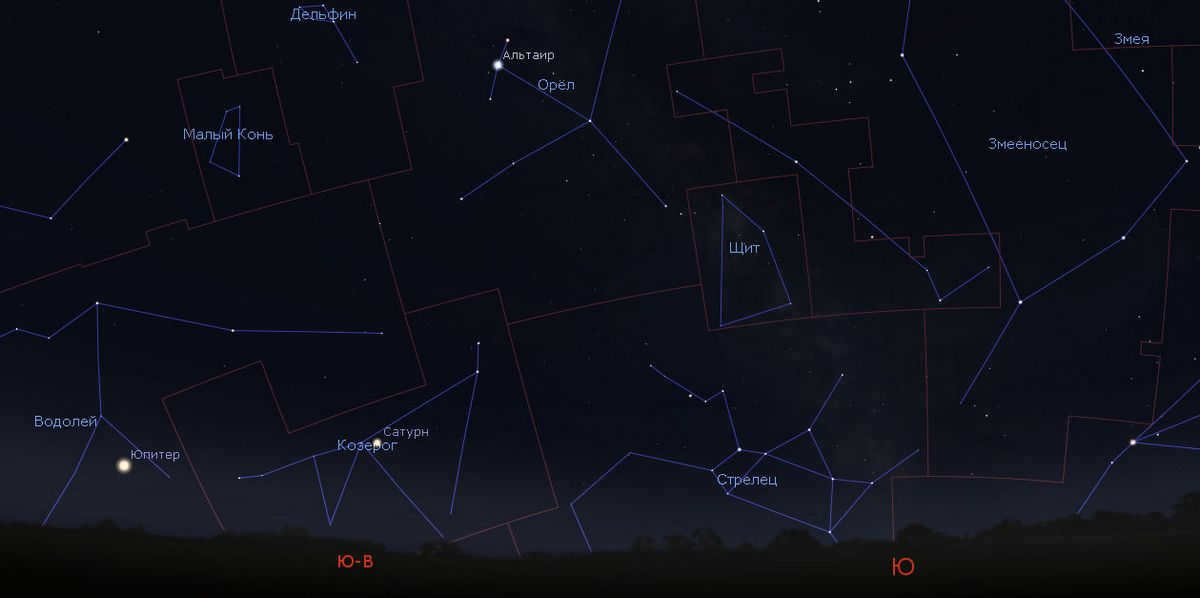
Sagittarius is a constellation that can be seen in the sky during the summertime in the middle zone. One of the notable features of this constellation is the asterism known as the “Kettle,” which can be easily observed.
This particular constellation is quite large, covering an area of 867 square degrees in the sky, making it the 15th largest constellation in terms of size.
Stars in the Sagittarius Constellation
The Sagittarius constellation is home to a multitude of stars, making it the densest area in the Milky Way. This is not surprising, as it is located in the central part of our galaxy. However, despite the density, there are no particularly bright stars that stand out in the night sky. The reason for this is that our Solar System is situated in one of the galaxy’s arms, and when we look towards Sagittarius, we are seeing it in a cross-sectional view, specifically in its narrowest section.
As we gaze further into the distance, we encounter more empty space, and the stars in the farther reaches of the galaxy are too distant to be seen with the naked eye. Consequently, when we look in the direction of Sagittarius, we are met with a faint glow, which is created by the collective light of billions of distant stars.
However, the center of the galaxy is located approximately 27,000 light-years away from us, and this vast distance is filled with an immense amount of gas and dust. As a result, when observing the constellation of Sagittarius, we primarily see a denser and slightly brighter section of the Milky Way compared to other regions, with no significant visual differences. Consequently, scientists have turned to studying the galaxy’s center using radio waves, as they are not hindered by the gas and dust. Optical telescopes, regardless of their size, are essentially ineffective for this purpose.
Admittedly, there are indeed certain stars within the Sagittarius constellation that shine more brightly than the rest and possess their own unique names. Let’s explore the significance of a few of these stars.
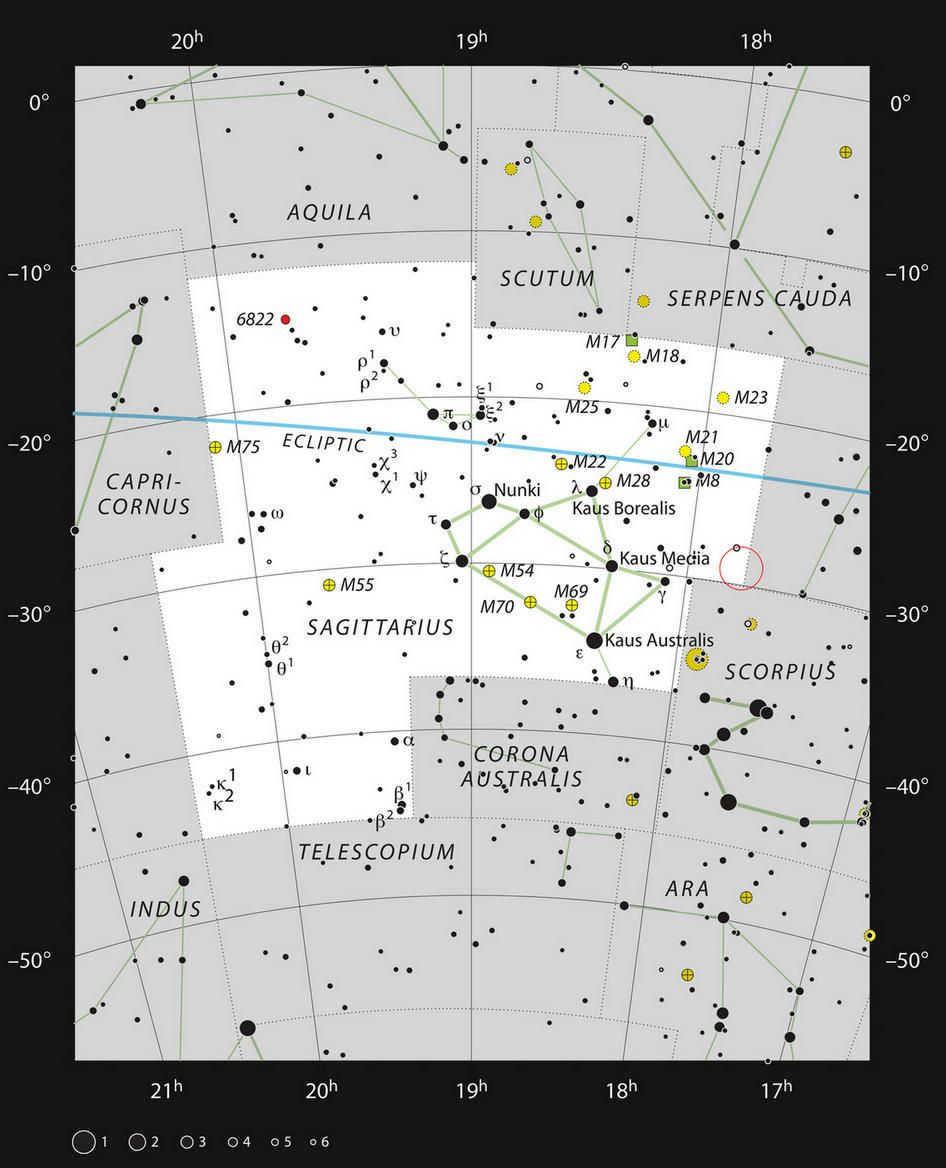

Kaus Australis – The Brightest Star in Sagittarius
Contrary to its letter designation, the brightest star in Sagittarius is not an alpha. Kaus Australis, also known as Epsilon Sagittarii, shines with a luminosity of 1.79 m, similar to the stars in the Big Dipper. Located approximately 145 light-years away from Earth, Kaus Australis dominates the constellation.
This star is not a single entity but a binary system. The primary component is significantly larger than our Sun, with a mass five times greater and a size seven times larger. It radiates 375 times more light and boasts a surface temperature of about 9200 K, making it a relatively massive and hot star.
The secondary star in this binary system is less remarkable, closely resembling the mass of our Sun but weighing 5% less.
Kaus Australis is situated at a low position, making it visible only in the southernmost parts of the Russian Federation. In regions with middle latitudes, it remains below the horizon.
Sigma Sagittarius – Nunki
Nunki, the second brightest star in the constellation, has a magnitude of 2.05. There isn’t much to say about Nunki as it is an unremarkable blue-white main sequence star. Its color suggests that it is extremely hot, with a surface temperature reaching 18890 K.
Nunki is 4.5 times larger than the Sun and 7.8 times more massive. Additionally, it emits 3300 times more light. It is also known to be a source of X-rays.
Due to its position in the ecliptic plane, Nunki occasionally experiences eclipses by the Moon and planets. This astronomical phenomenon is fascinating and worth observing.
Zeta Sagittarius – Askella
This celestial body is more intriguing compared to its predecessors, although its knowledge remains limited. It is, in fact, a binary system, and potentially even a trinary system.
One of the constituent elements possesses a luminosity of +3.26 m, while the other exhibits a luminosity of +3.47 m. However, when observed together, their combined luminosity amounts to +2.61 m, giving Askella its overall brightness.
Component A within this system is a star that is 3.27 times larger than the Sun. It also boasts a mass 2.2 times greater and a luminosity that is 31 times more powerful. Furthermore, it is twice as hot as the Sun, with a surface temperature of 9000 K.
Component B, on the other hand, is slightly smaller, with a mass equivalent to 2.1 solar masses. Its luminosity is measured at 26, and its surface temperature is slightly lower at 8500 K.
These two celestial bodies are situated at a distance of approximately 10.6 a.u. to 16.1 a.u. from each other – their orbit is not perfectly circular. In other words, they move closer and farther apart, with the minimum distance between them being comparable to the distance from the Sun to Saturn, and the maximum distance being almost as far as Uranus. A complete revolution of these celestial bodies around a shared center of mass takes place over a span of 21 years.
Due to the close proximity of these two stars in the Askella system, it is unlikely for planets to exist there. Planets would be unable to maintain a stable orbit and would be ejected from the system. Additionally, it is improbable that planets formed in this region. If any planets do exist, they would be located very close to their star, similar to Mercury, as the gravitational pull from another star would disrupt their orbit.
Another star, known as component C, is located at a distance of 71.6″ from the double system. It has a brightness of 10.6 m. However, it is currently unclear whether it is gravitationally bound to the other stars or merely situated along the same line. If it is indeed part of the system, it would need to be at least 2000 a.u. away from the central pair. In that case, its orbital period would be approximately 40000 years. Despite ongoing astronomical observations, no changes in the orbit of this star have been detected thus far. As a result, the question of its affiliation with the Ascella system remains unanswered.
Nebulae in the Sagittarius Constellation
Due to its position in the center of the Milky Way, the Sagittarius constellation boasts a multitude of unique nebulae and star clusters. Below, we will outline some of the most well-known and easily observable ones.
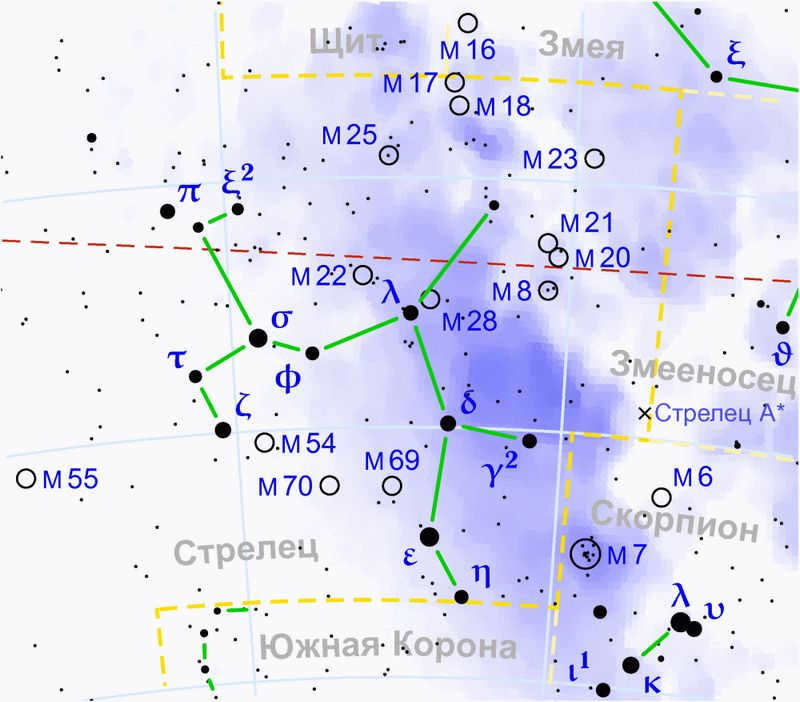
The Lagoon Nebula (M8, NGC 6523) is a luminous gas nebula with a magnitude of 6. This massive cloud is located at a distance of 4100 light years. The process of star formation is currently taking place within this region. Additionally, situated at the core of the Lagoon Nebula is another fascinating nebula known as the Hourglass Nebula.
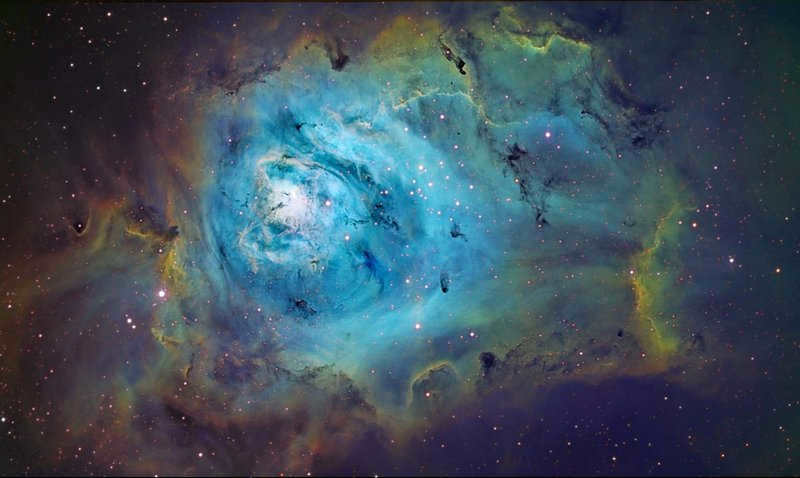
The stunning image captured by the Hubble telescope showcases the Lagoon Nebula.
Also known as the Omega Nebula (M17, NGC 6618), this celestial object is often referred to as the Horseshoe Nebula, Swan Nebula, and Lobster Nebula. It is an expansive gas nebula spanning 15 light-years and is illuminated by a cluster of 35 young, hot stars from within. With a magnitude of 6 m, it is located at a distance of approximately 5-6 thousand light-years.
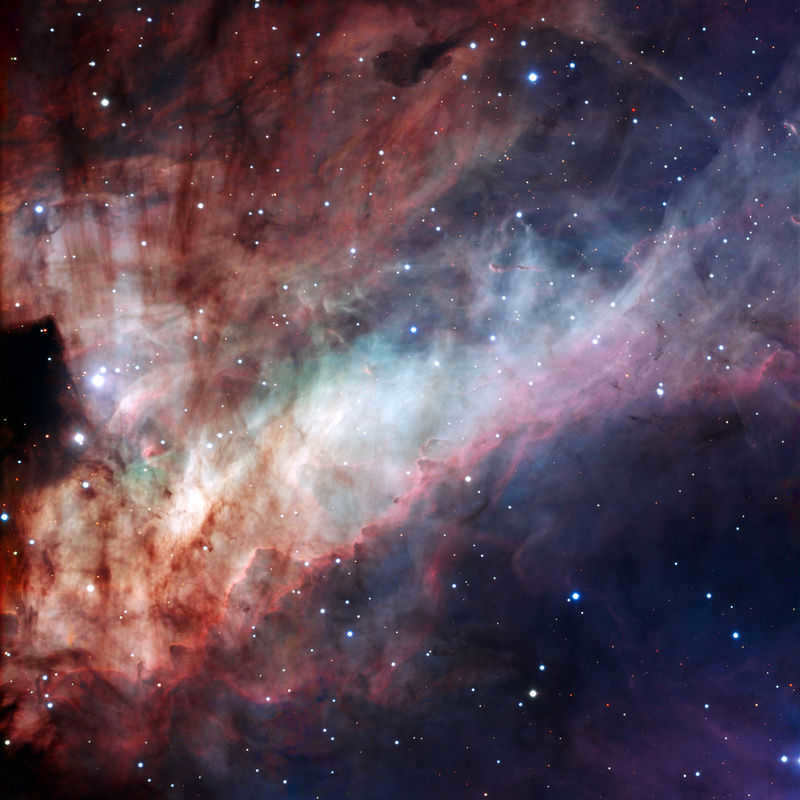
The Omega Nebula is located in the Sagittarius constellation.
The Triple Nebula (M20, NGC 6514) is a combination of an emission and a reflective nebula. It is situated at a distance of 5200 light-years from us and has an apparent brightness of 6.3 m. The lower part of the nebula emits light independently, as the gas is ionized by high-energy photons emitted by nearby stars. The upper part of the nebula reflects light, as it is illuminated by surrounding sources. This nebula can be easily observed even with a small telescope, as its apparent size is 28 angular minutes.
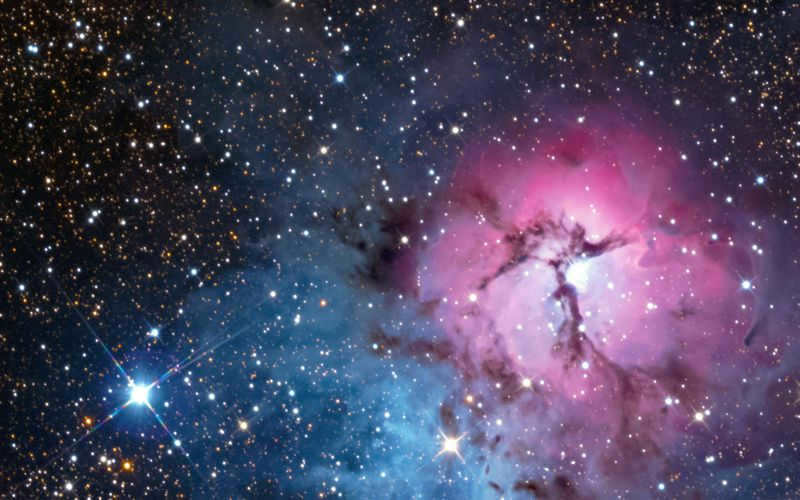
Observing the planetary nebulae NGC 6565 and NGC 6578 can be quite challenging due to their brightness levels of 11.6 m and 12.9 m respectively. These objects require advanced observation techniques.
Initially, it is important to acknowledge the immense Sagittarius Star Cloud, positioned approximately 10,000 light-years away from our current location, with a width of 600 light-years. This particular region boasts an exceptionally high density of stars, yet it differs from a globular cluster as it forms part of the adjacent Sagittarius arm of our galaxy. This arm is situated closer to the galactic center and exhibits a greater level of density. The Sagittarius arm is abundant in nebulae and young stars, while we find ourselves situated in the Orion arm, which is located in a different region of the galaxy.
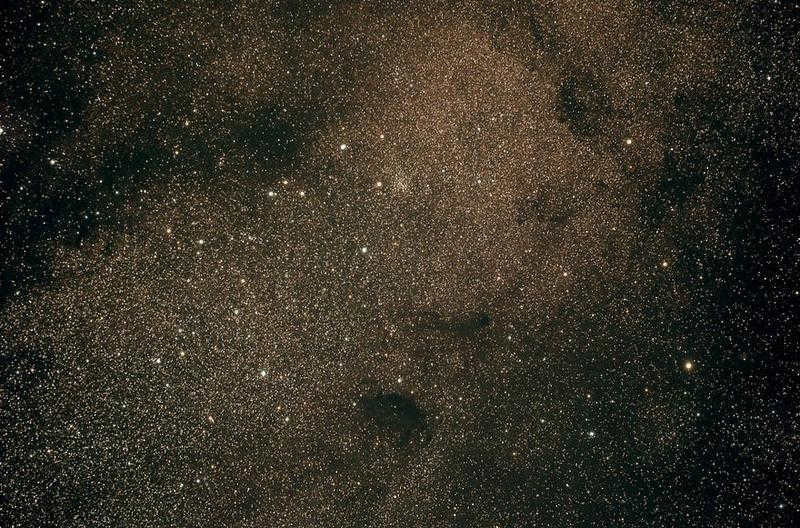
The Sagittarius Star Cloud and the M 24 cluster can be seen in the background.
When observing the Sagittarius Star Cloud through binoculars, one can witness the dazzling display of 1000 stars simultaneously shining. This region is renowned for being the most densely populated area of stars within the Milky Way that we are able to observe.
Moreover, the constellation of Sagittarius is home to numerous star clusters of various types.
M 18, also known as the Black Swan, is a diffuse cluster situated near the Omega Nebula (M 17), making them a captivating sight when observed together. The cluster has a magnitude of 7.5 and is located approximately 4600 light-years away. Remarkably, this cluster is relatively young, with an age of only 30 million years.
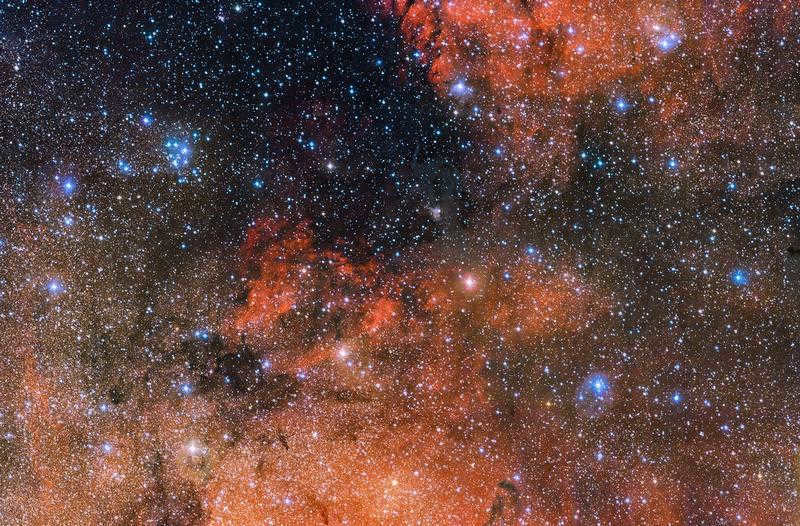
The M 18 star cluster (located in the upper left corner) can be easily identified with the help of binoculars. In close proximity, you can also find the Omega Nebula.
M 21 is a diffuse cluster that appears to be about half the size of the moon’s disk in the night sky. Its brightness is 6.5 m, making it relatively easy to spot. This cluster is considered young, with an age of only 4.6 million years, and it is located approximately 4250 light years away. It consists of a total of 57 stars.
M 22 is a globular cluster that is located closer to the center of the Galaxy, near the galactic bulge. Within this cluster, there is a planetary nebula, which is one of only four known clusters to have such a feature. With a brightness of 5.1 m and a distance of 10600 light years, M 22 is considered one of the closest globular clusters, although there are many others that are much farther away.
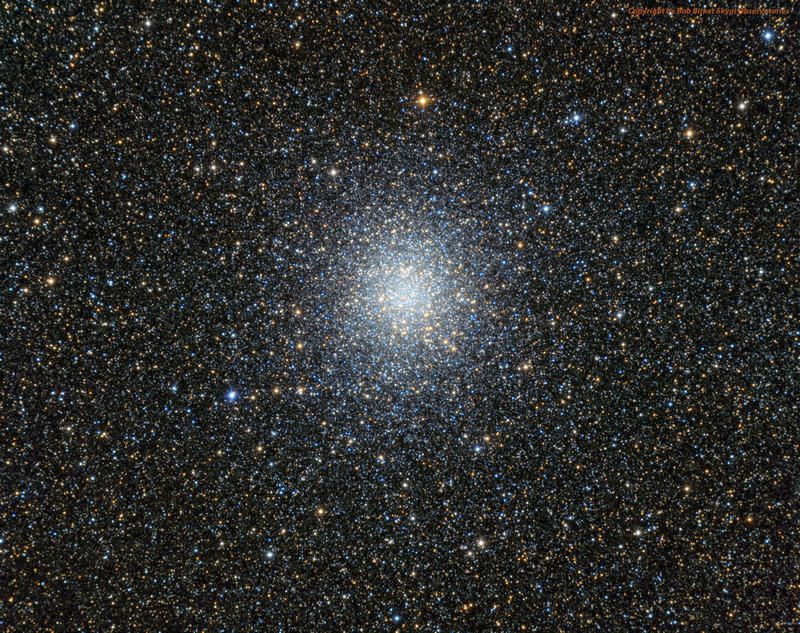
The globular cluster M 22 in Sagittarius.
M 23 – is an expansive cluster situated 2150 light years away. In a span of 15020 light years, there exist around 150 stars. The cluster’s overall brightness measures 6.9 m. It is easily observable through a small telescope and presents a magnificent sight. The only drawback is its low position above the horizon.
M 25 – is yet another cluster positioned 2000 light-years away, boasting a brightness of 4.6 m.
M 28 – represents a globular cluster with a brightness of 7.66 m, situated 18000 light-years away. This particular cluster contains a total of 18 pulsating variable stars of the RR Lyra type. Furthermore, in 1987, a millisecond pulsar was also discovered within this cluster, marking the second pulsar discovery in the cluster’s history.
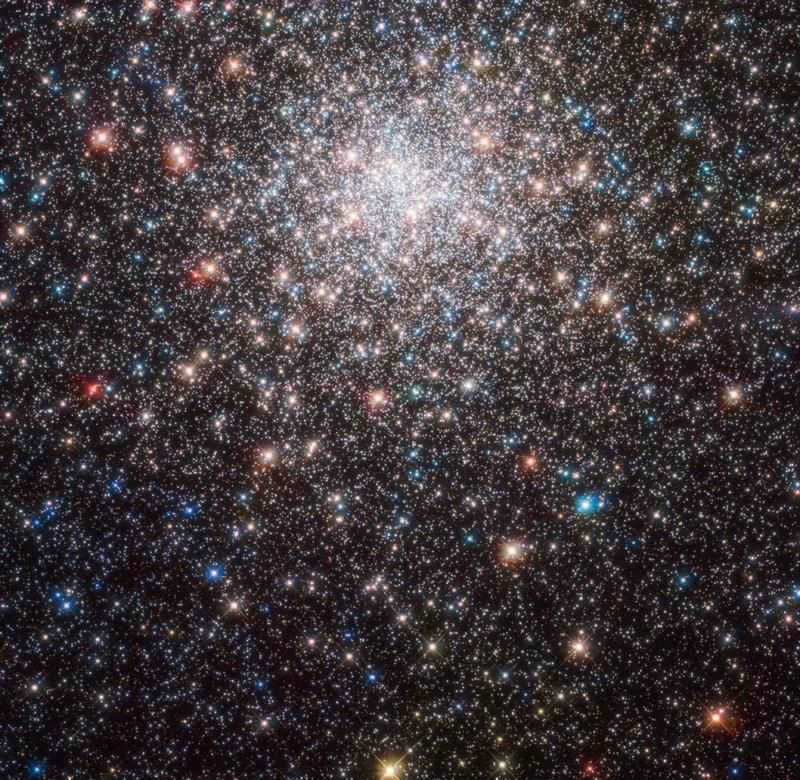
M 54 is an incredibly dense globular cluster that has a magnitude of 8.37. Its distance from us is an astounding 87400 light years. However, what sets this cluster apart is the fact that it serves as the core of a dwarf elliptical galaxy. This galaxy happens to be a close neighbor of our very own Milky Way and is currently moving towards it. In the next million years, the central region of our Galaxy will experience a collision with the cluster M 54, which resides at its core.
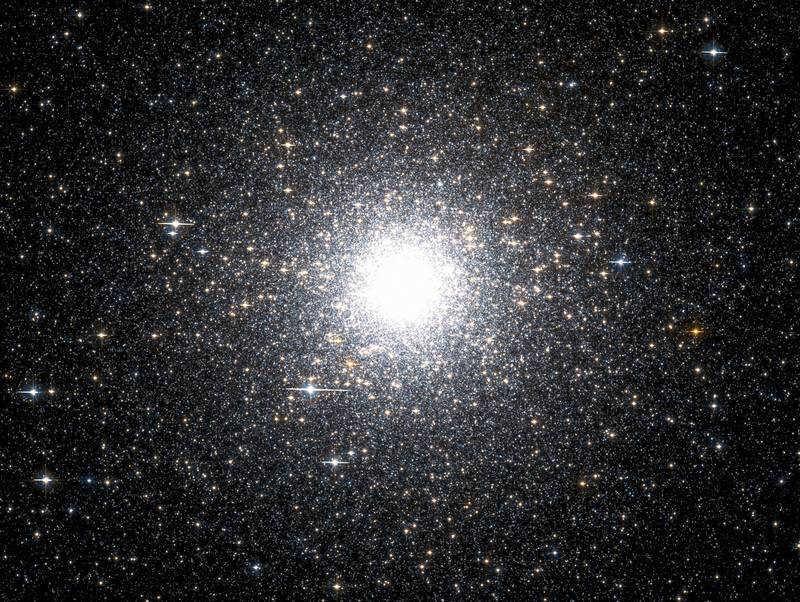
M 54 is the central globular cluster of a dwarf galaxy.
In the Sagittarius constellation, there are various other star clusters that are not as bright but can be observed with small and medium-sized amateur telescopes. These include the globular clusters M 55, M 69, M 70, M 75, and NGC 6522.
There is also another galaxy present in this area known as the Barnard Galaxy, designated as NGC 6822. It has a magnitude of 9.3 and is located 1.63 million light-years away. This irregular dwarf galaxy is similar to the Small Magellanic Cloud.
Furthermore, the Sagittarius constellation hosts a significant number of variable stars. Edwin Hubble himself discovered 15 of them, including 11 cepheids, which are pulsating giants and supergiants.
The Sagittarius constellation offers a plethora of fascinating astronomical objects across various categories. To explore these cosmic wonders, we suggest utilizing the Stellarium program (available in a smartphone version) or consulting any of the atlases specifically designed for this purpose.
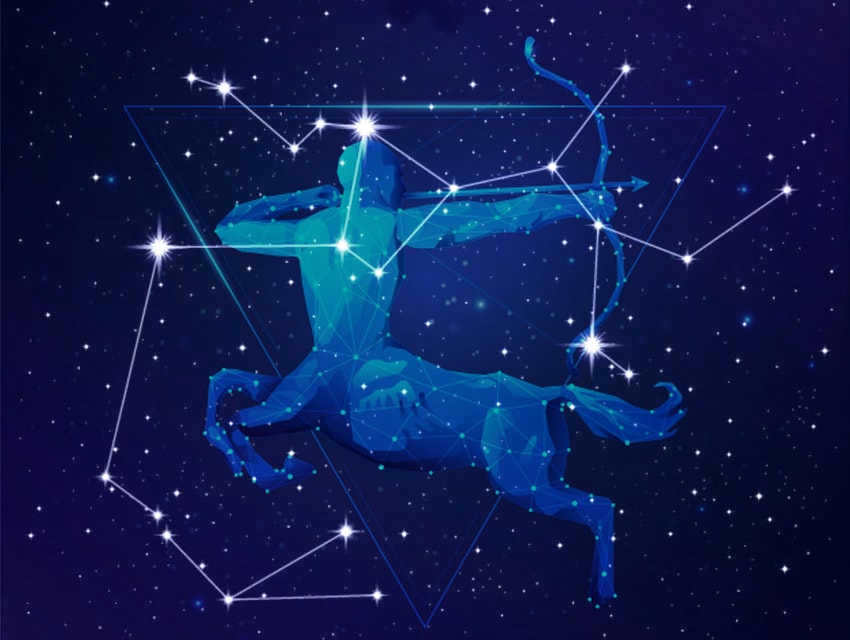

Sagittarius is one of the twelve constellations that make up the zodiac. Every year, the Sun travels along its ecliptic path.
Astronomers have a special interest in Sagittarius because it is where the winter solstice occurs and it is also the center of the Milky Way Galaxy. This location is incredibly far from the Sun.
To truly grasp the immense distance, consider that the Sun takes 200 million years to complete one revolution around the center of the Galaxy while traveling at a speed of 220 kilometers per second!
Study’s Background
The study of the constellation Sagittarius dates back to ancient times. Its name was proposed by the ancient Greek Cleostratus, and Claudius Ptolemy documented it in his Almagest catalog of the celestial sphere. The first reference to this constellation in Russia can be traced back to 1073 in the “Izbornik Svyatoslav”.
In ancient Babylon, the constellation was linked to the Akkadian mythological deity Nergal – a mythical creature resembling a centaur and known for its archery skills.
In ancient Mesopotamia, dating back to the 2nd millennium B.C., there existed a constellation known as PA.BIL.SAG or AK, which was documented in the cuneiform tablets called MUL.APIN. This particular name is sometimes left untranslated and transcribed as Pabilsag, while other times it is translated as Fire Arrow Issuer or Fire Archer. In later Babylonian depictions, the constellation is depicted as a centaur shooting arrows, similar to how the Greeks portrayed it.
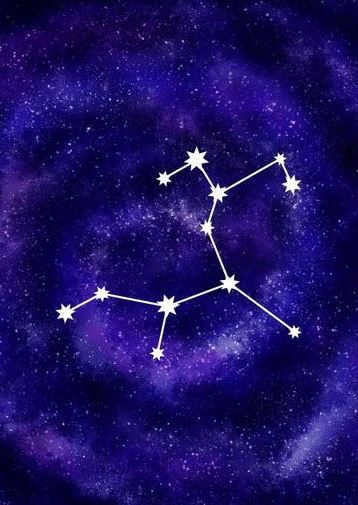
Cleostratus of Tenedos, an ancient Greek astronomer, is credited with inventing the constellation Sagittarius. He was known for his extensive knowledge of the zodiacal constellations and was the first in Greece to provide a comprehensive and detailed description of them, including those that were previously overlooked.
However, many scientists are skeptical of Pliny’s testimony when it comes to astronomical matters.
According to historical records, Cleostratus of Tenedos also proposed the name Sagittarius for the constellation. It is believed that he also brought over the other constellations from Babylonian mythology. In ancient Greek legends, Sagittarius is associated with the centaurs Krotos and Chiron.
Description of the Constellation

Out of all the celestial objects that are visible in the nighttime sky without any aids, this particular constellation is truly remarkable. It is widely believed to be the location of the central region of our very own Galaxy. Some of the stars within this group shine with a visual magnitude as high as 0.2, which makes them quite brilliant and easily distinguishable.
Sagittarius holds the 15th position in terms of magnitude among all the constellations. It covers an area of 867 square degrees. The ecliptic line passes through the widest part of this constellation, and the Sun directly transits Sagittarius for a duration of 32 days!
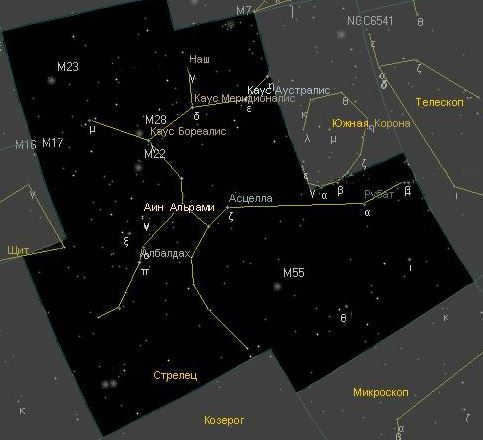
The constellation known as “SAGITTARIUS” and abbreviated as “SGR” holds the Latin name. It carries the symbolic representation of Sagittarius. Its range of direct ascension spans from 17.36 to 20.20. Additionally, there are two significant meteor streams present.
Sagittarius can be found situated south of the celestial equator, surrounded by constellations that may be unfamiliar to those in the northern hemisphere. These constellations include Snake, Serpentor, Southern Crown, Telescope, Indian, and Microscope. However, there are also more recognizable border constellations such as Scorpio, Capricorn, Eagle, and Shield.
From December 18 to January 19, the Sun passes through the constellation Sagittarius. Ranked fifth among the zodiacal constellations in terms of distance along the ecliptic, Sagittarius (Sagittarius,) is the current placement.
Stars in Sagittarius
Sagittarius is made up of around 200 faint stars and a few fascinating celestial objects. The dominant star in the constellation goes by the name Rakbat, although it is not the most luminous star in Sagittarius. Its name originates from the Arabic term “Ar-Raqba,” which translates to “knee,” denoting its location in the archer’s body. It is also commonly referred to as Alrami.
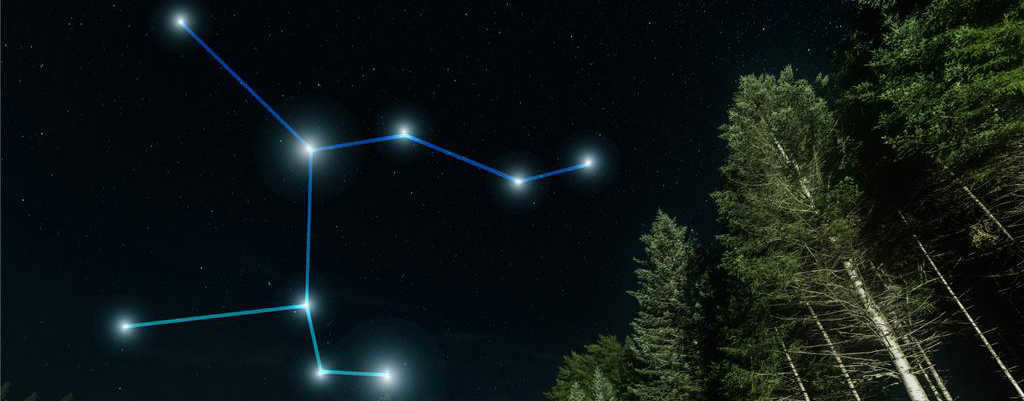
The star Rakbat, which is located in the Sagittarius constellation, is estimated to be around 170 light years away from Earth. With an apparent magnitude of +3.97, Rakbat is easily visible to the naked eye. Its bluish-white hue sets it apart from other stars in the night sky. In terms of brightness, Rakbat shines 112 times brighter than our Sun. Its composition is similar to that of a typical star found in a solar system.
Another notable star in the Sagittarius constellation is Sigma Sagittarii, which is the second largest star in the constellation.
When observing the Sagittarius constellation, there are a total of 7 stars that can be seen without the need for any special equipment:
- Epsilon Causus Australis (Southern Bow) – The Southern Bow, also known as Epsilon Causus Australis, is a blue giant star. It has a right ascension of 18 hours 24 minutes and a declination of 34 degrees 23 minutes. This star is a binary system, with a dwarf companion. It shines with a brightness that is almost 400 times greater than that of the Sun. In terms of mass and radius, Epsilon Causus Australis is 5 and 7 times larger than the Sun, respectively.
- Sigma Nunca or Pelaguc (Rapid Stream) – Sigma Nunca, also known as Pelaguc or Rapid Stream, is a blue star with a companion. It is the second brightest star after the Southern Onion. Its coordinates are longitude 18 hours 55 minutes and latitude 26 degrees 17 minutes. The mass of this star is equal to 8 solar masses, and its radius is 4.5 times that of the Sun.
The most prominent star clusters serve as navigational aids and can be easily spotted in the southern sky. On the other hand, Alpha (Rukbat) and Beta are less luminous and reside in the outskirts of the system.
- Zeta Askella (Armpit). – A binary system with white stars, known for its combined stellar magnitude. It ranks third in terms of luminosity, following Sigma and Epsilon. The system consists of a giant star and a subgiant star, with apparent magnitudes of 3.26 and 3.37, respectively.
- Pi Albaldach (City). – A massive triple star system with a yellow spectrum. Its luminosity is approximately 1,000 times greater than that of the sun. Notable for its unstable gravity and internal pressure, which cause it to undergo periodic contractions and expansions.
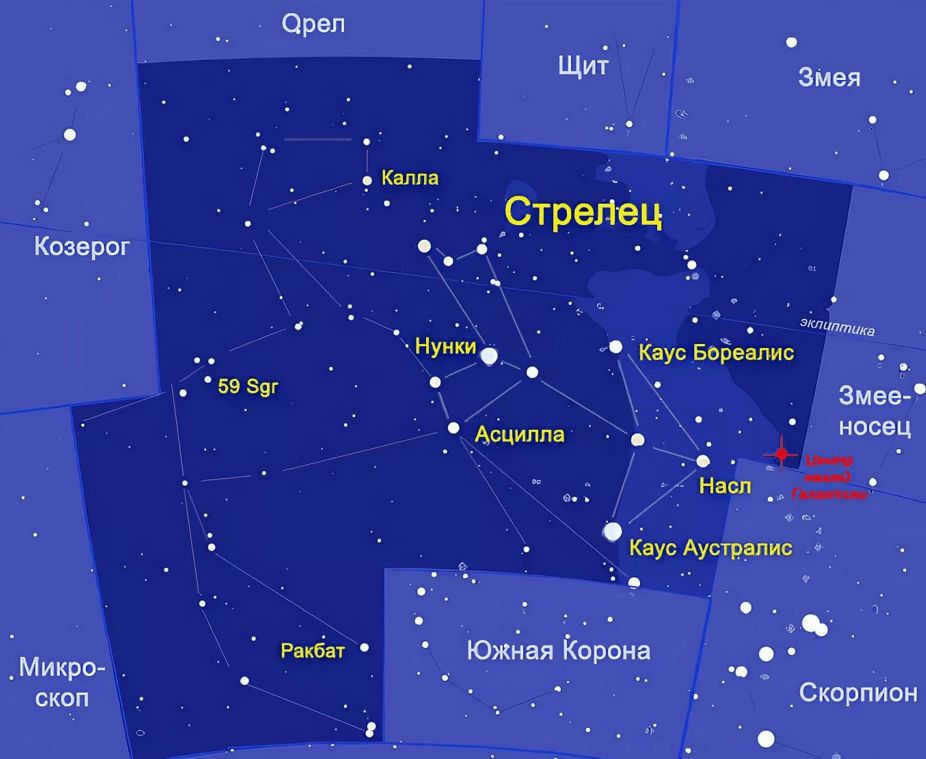
- Gamma Nasl, Nushaba (Arrowhead) – an uncommon example of stars with two traditional names. Its temperature, mass, and brightness surpass those of the Sun by several times.
- Delta Kaus Media (Middle Onion). – A multiple star system with a spectrum that appears yellow-orange.
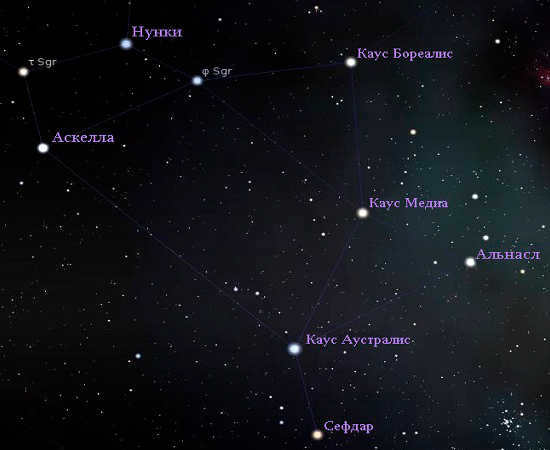
- Lambda Kaus Borealis (Northern Onion) is a subgiant that appears yellow-orange. It can be found 2.1 degrees south of the Sun’s apparent motion. Occasionally, it may be blocked from view by the Moon or other planets.
Unique Blue Star
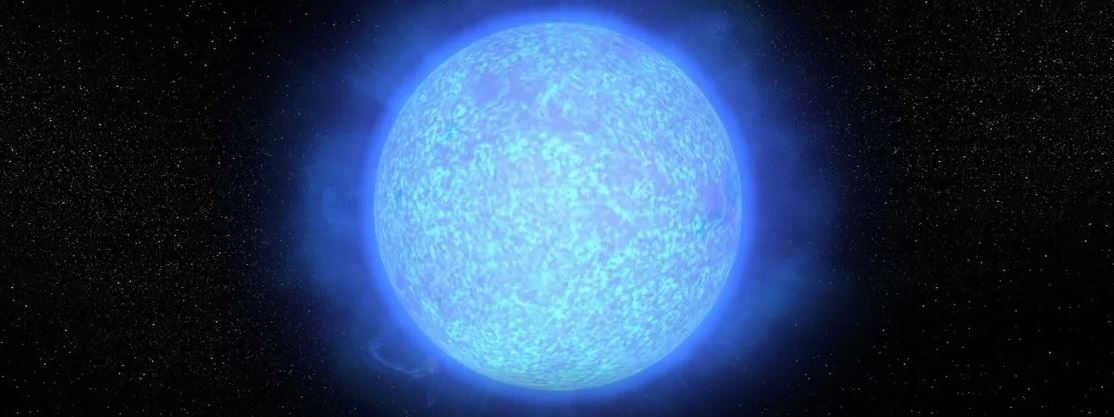
Sagittarius is home to an incredibly bright star known as the hypergiant Blue Star, which can be found in the Milky Way.
Despite its high level of brightness, this star is difficult to see with the naked eye due to the presence of a significant amount of interstellar dust surrounding it. It is located within a densely populated region that includes many large, young stars. This region is known as the Fivefold Cluster and is situated near the center of the galaxy, approximately 25,000 solar years away.
Objects in the field of astronomy
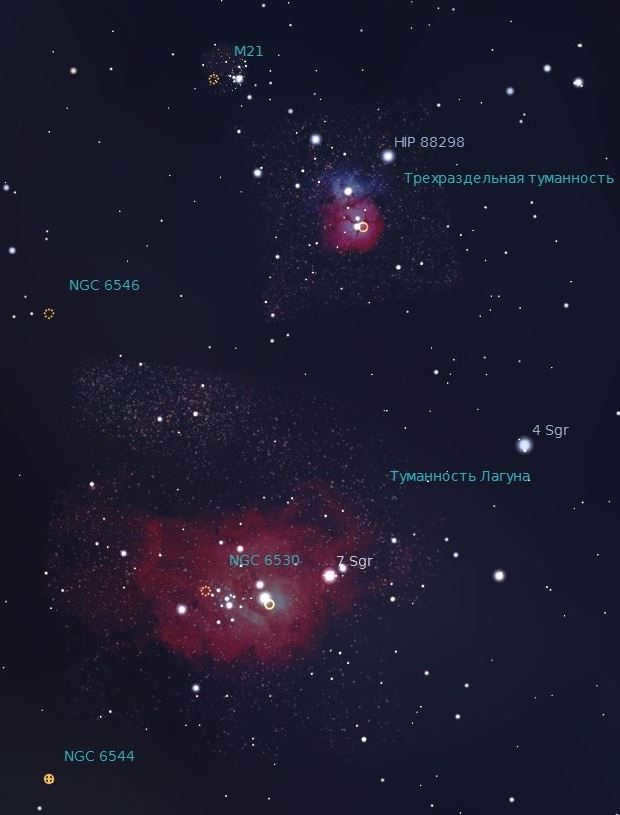
Within the Sagittarius constellation, there are fascinating celestial objects worth exploring:
- The M20 Triple Nebula – This nebula showcases a dominant red hue, which is a result of the abundance of hydrogen within the cloud. Scattered throughout the nebula are young stars with a vibrant blue color, creating a captivating contrast against the overall backdrop. The nebula features three distinct colors: emission pink, reflection blue, and absorption black. Even amateur astronomers can observe this nebula using a telescope.
- The Lagoon Nebula (M8) is a massive cloud of ionized hydrogen in space. It was first observed by Guillaume Lejeantil in 1747. The shape of this nebula is oval, with its core resembling the petals of a flower made up of stars. Located within the Lagoon Nebula is another nebula known as the Hourglass Nebula. This region is actively forming new stars. The Lagoon Nebula can be easily seen in the night sky without the need for any special equipment, just with the naked eye or a pair of regular binoculars.
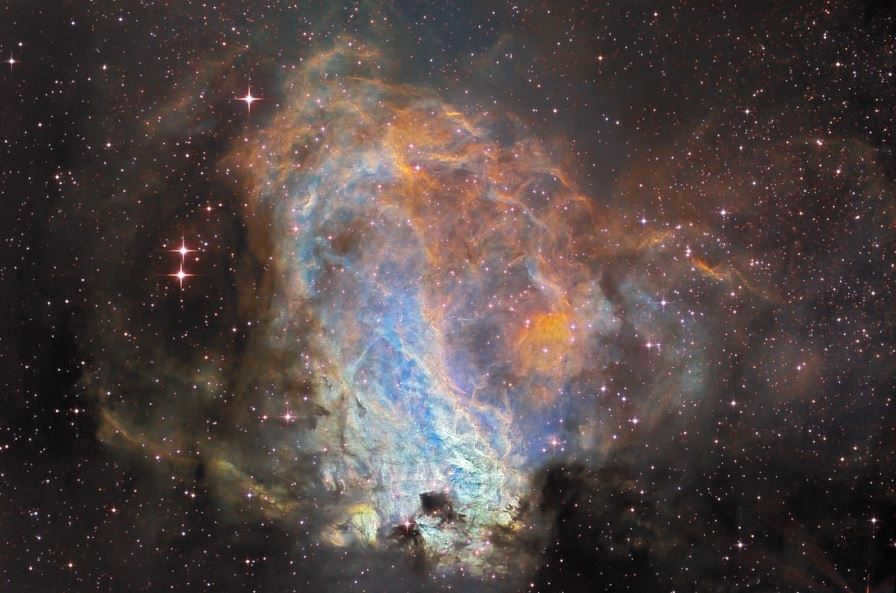
- Omega-Messier Nebula17 (Swan, Horseshoe or Lobster Nebula) – A glowing cloud of gas and dust located in the Sagittarius constellation. It has an apparent magnitude of 6.0 and is estimated to be 5000-6000 light-years away. The nebula spans 15 light-years in diameter and contains a cluster of 35 young and hot stars that illuminate its gases. This celestial region was first observed by Jean Philippe de Chézeau in 1745.
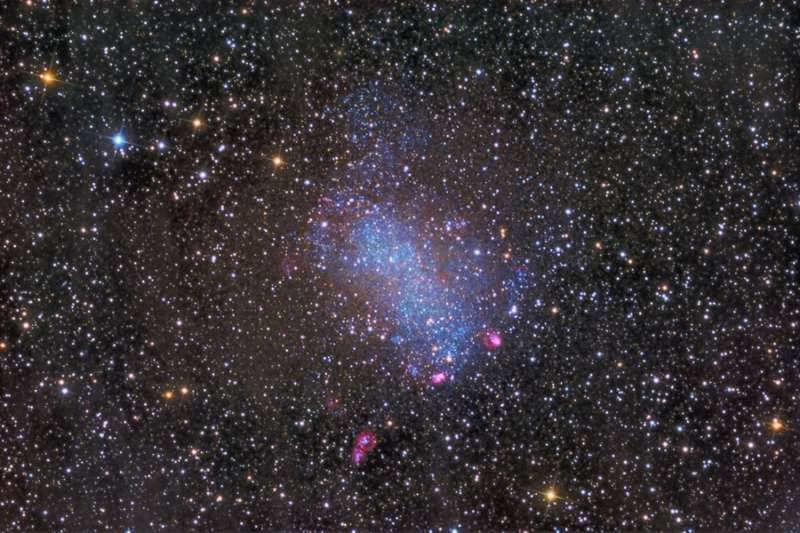
- Barnard Galaxy – A galaxy of irregular shape with a junction. It can be found within the Local Group of galaxies. With a visible visual magnitude of 9.3 and a distance of 1.63 million light-years, this galaxy is named after its discoverer, E.E. Bernard. In 1881, Bernard utilized a 6-inch refractor telescope to make this discovery.
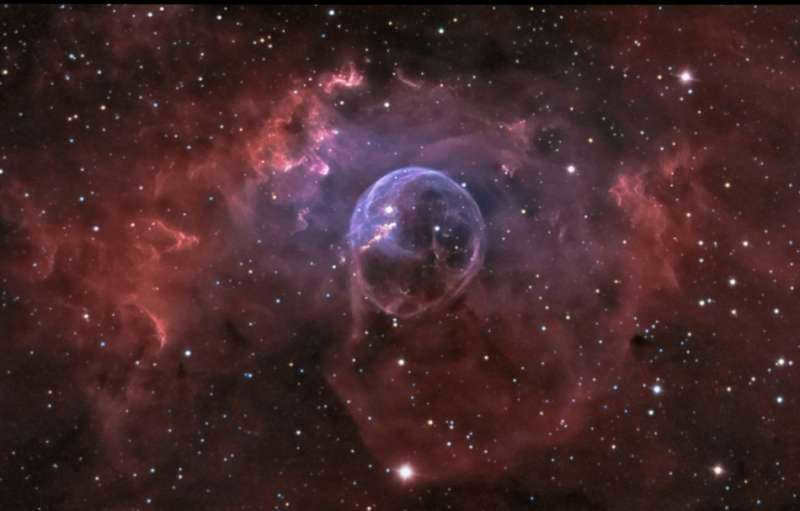
- The Bubble Nebula is situated in the Bernard Galaxy. It contains areas with significant H II emission and extensive patches of partially ionized gas, indicating the occurrence of recent star formation.
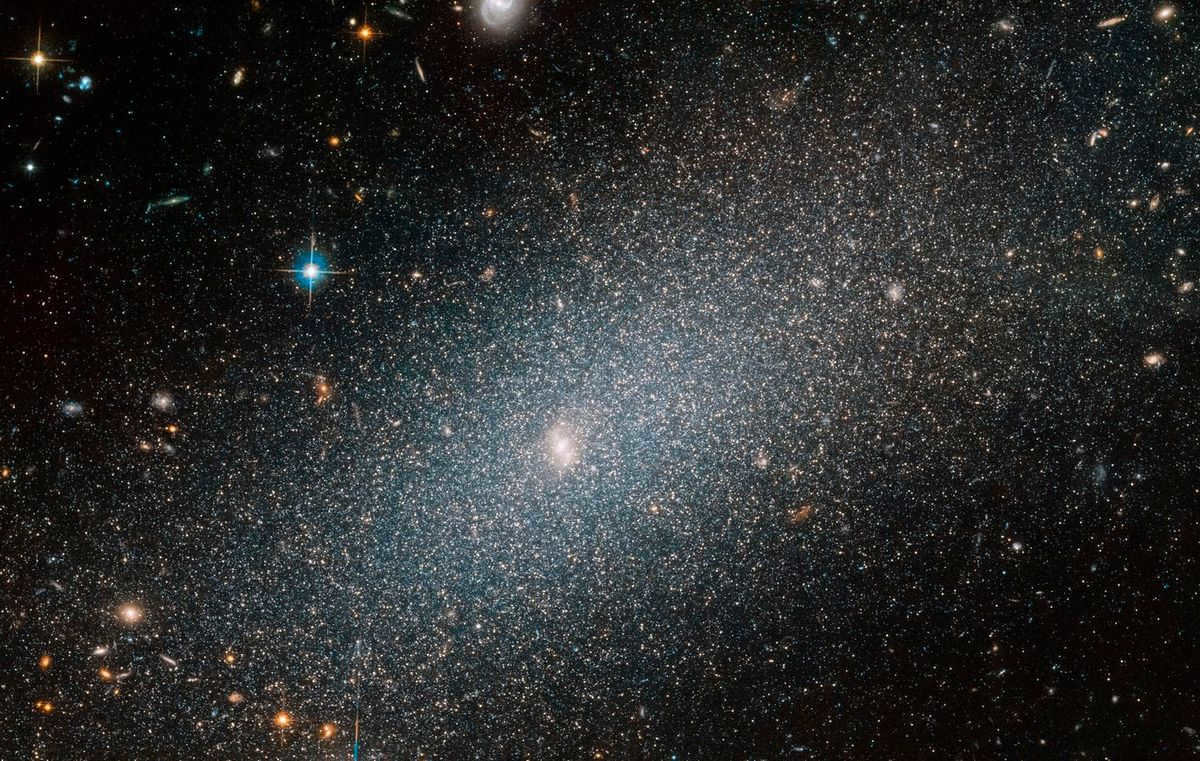
- A dwarf elliptical galaxy has a distinctive loop shape and a visual magnitude of 4.5. It is located at a distance of 65,000 light-years. The diameter of this galaxy stretches up to 10,000 light-years and it is home to 4 globular clusters.
Sagittarius A is a radio emission that can be found at the precise center of the Milky Way. This particular phenomenon is not easily observable due to the presence of extensive dust clouds scattered throughout the spiral arms of our galaxy.
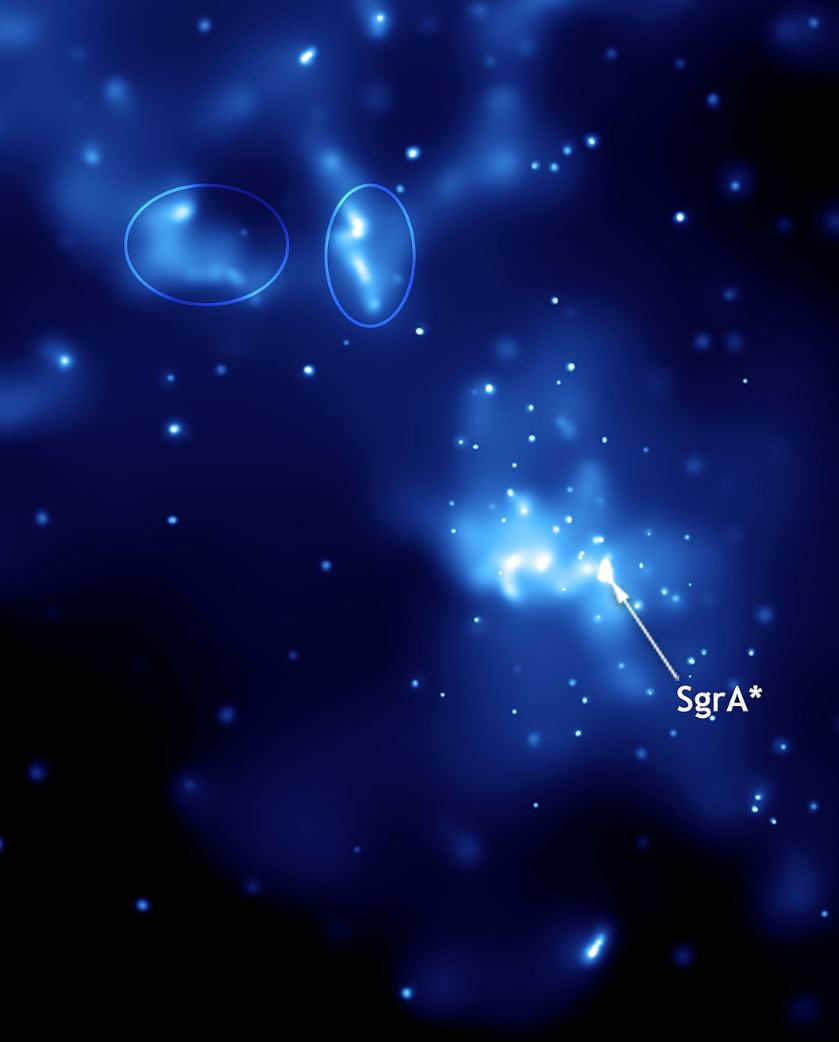
The following objects make up Sagittarius A:
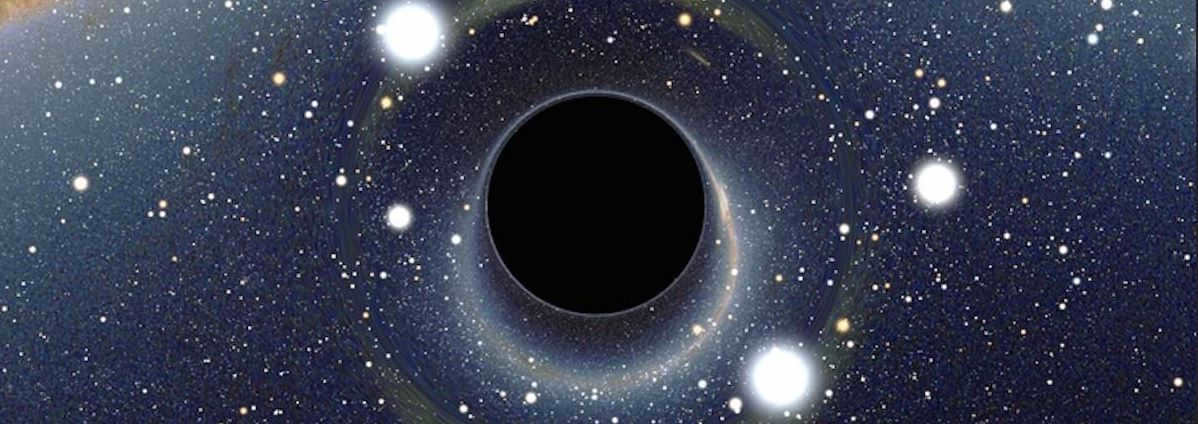
- Sagittarius A West resembles a spiral with three arms on the outside, but it does not have a spiral structure. This formation is composed of dust and gas clouds that surround Sagittarius A* and fall onto it at incredible speeds, reaching up to 1000 km/s.
- Sagittarius A* is considered the leading contender for hosting the supermassive black hole at the center of the Milky Way. The stars in our galaxy orbit around this object at a faster rate compared to other stars.
- Sagittarius A East – A supernova remnant formed by a powerful explosion that took place between 35,000 and 100,000 years ago. It spans an impressive 25 light years in diameter. Scientists speculate that the explosion was triggered by the gravitational compression of the star as it approached the central black hole, leading to its massive size and energy reserve.
- Sagittarius B 2 is a massive molecular cloud composed of dust and gas. It is situated approximately 390 light-years away from the center of the Milky Way. This celestial object spans an impressive area of 150 light-years. Notably, it stands as one of the largest molecular clouds within our galaxy and holds the distinction of being the largest cloud in close proximity to the galactic nucleus.
- The NGC planetary nebula was first identified by William Herschel in the year 1787. This captivating nebula is believed to have acquired its elongated shape as a result of the forceful winds of material emanating from its intensely hot central star.
There are numerous star clusters of different sizes and visibility within Sagittarius.
The ones that have been extensively researched include:
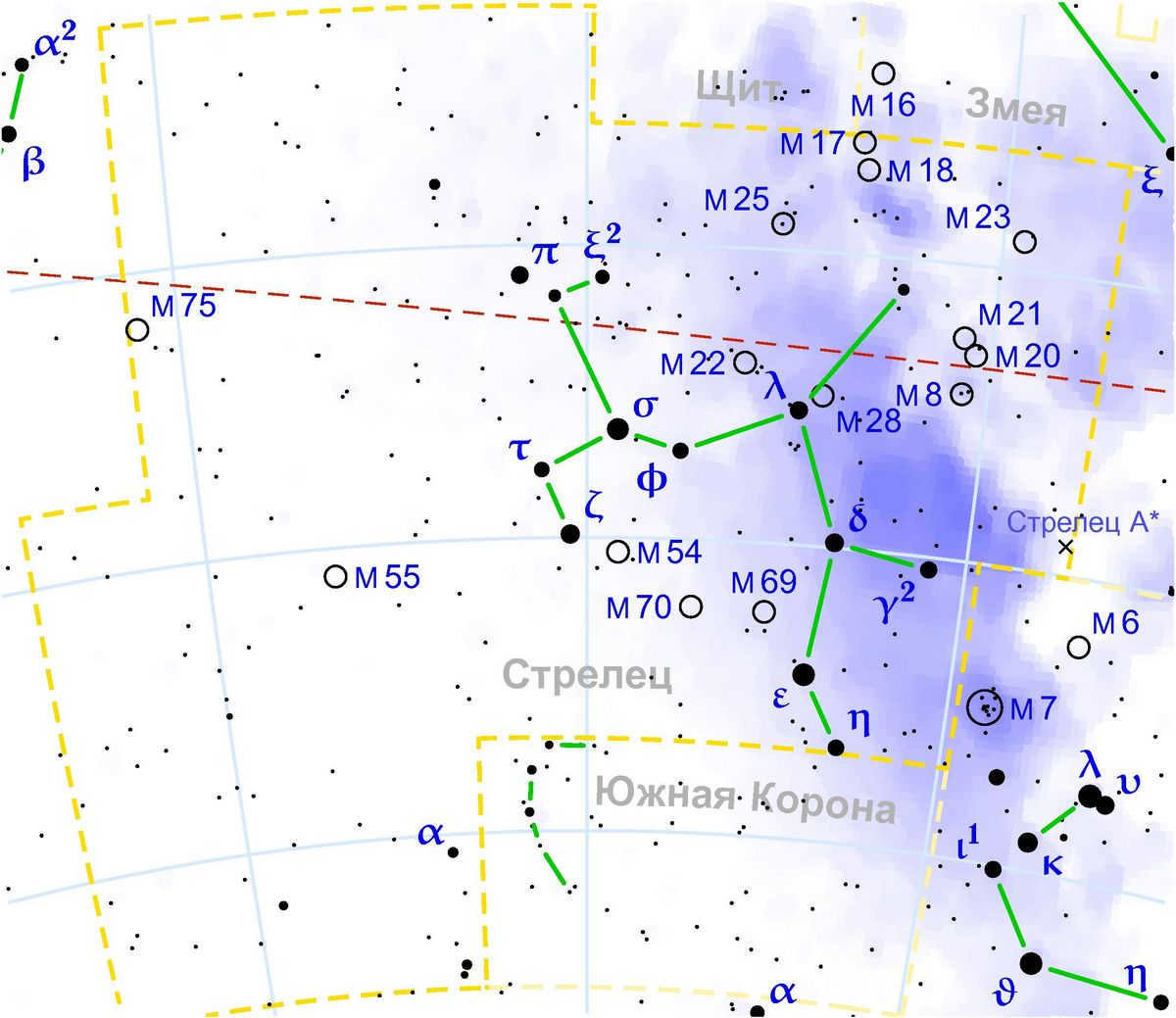
- Messier 18 is a star cluster situated at a distance of 4,900 light-years with an apparent visual magnitude of 7.5. It was first observed by Charles Messier in 1764 and is estimated to be around 32 million years old.
- Messier 21 is another star cluster in Sagittarius, approximately 4.6 million years old. It consists of 57 stars and is located 4250 light-years away. This cluster has an apparent magnitude of 6.5 and was discovered and added to Ch. Messier’s catalog in 1764.
- Messier 22 is a highly luminous cluster situated in close proximity to the galactic bulge. It has an elliptical shape and covers an angular area of 32 minutes. It has an apparent magnitude of 5.1 and is located at a distance of 10600 light years from Earth. This cluster was first observed by the amateur astronomer Igoann Abraham Ihle and was subsequently included in the catalog by Ch. Messier in the year 1746.
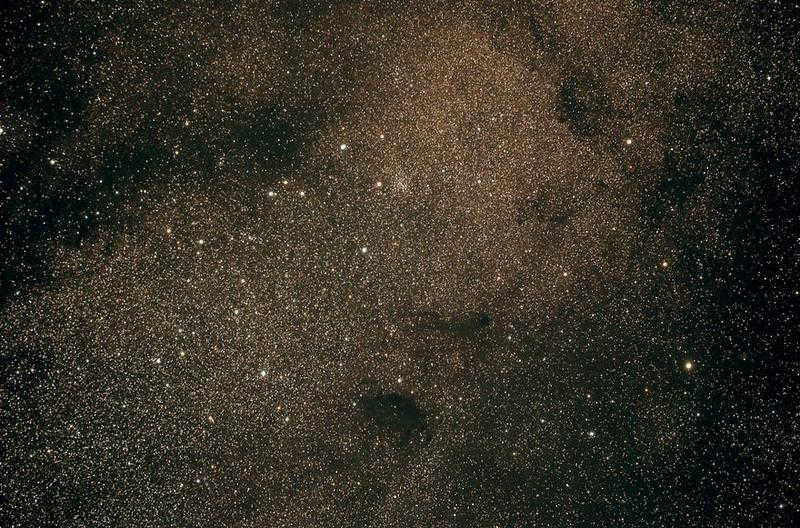
The background of the Sagittarius star cloud and the cluster M 24
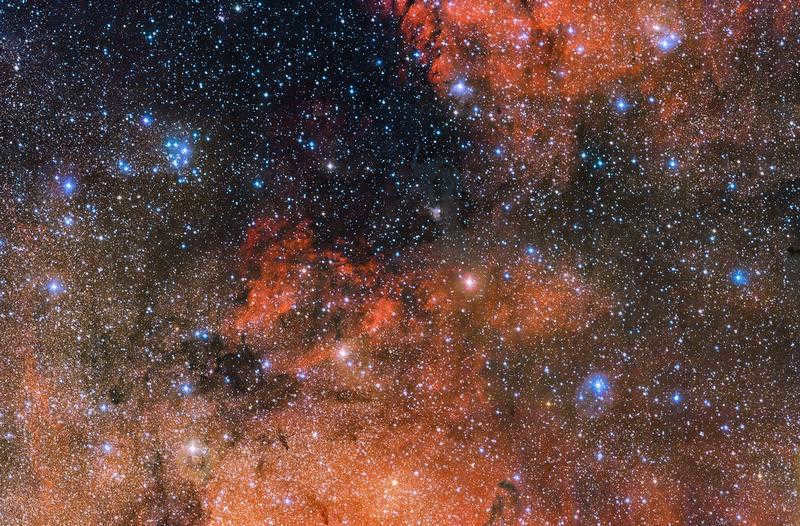
The star cluster M 18 (top left). Adjacent to it is the Omega Nebula
- Monsieur 23 – An open cluster that has a visible brightness of 6.9 and is located 2,150 light-years away. It measures approximately 20 light-years in radius and contains 150 stars. The brightest star in the cluster has a brightness of 9.2. This cluster was first observed by Ch. Messier in 1764.
- The Sagittarius M24 star cloud – is the most densely populated area of stars (up to 1000 stars) that can be observed even with binoculars. The cloud spans a distance of 600 light years and is located 10,000 light years away. It was discovered by Ch. Mesier in 1764.
- Messier 25 – an open cluster with a brightness of 4.6 and a distance of 2000 light-years. It spans a width of 19 light years and is 90 million years old. It was discovered in 1745 by Jean Philippe de Chézeau.
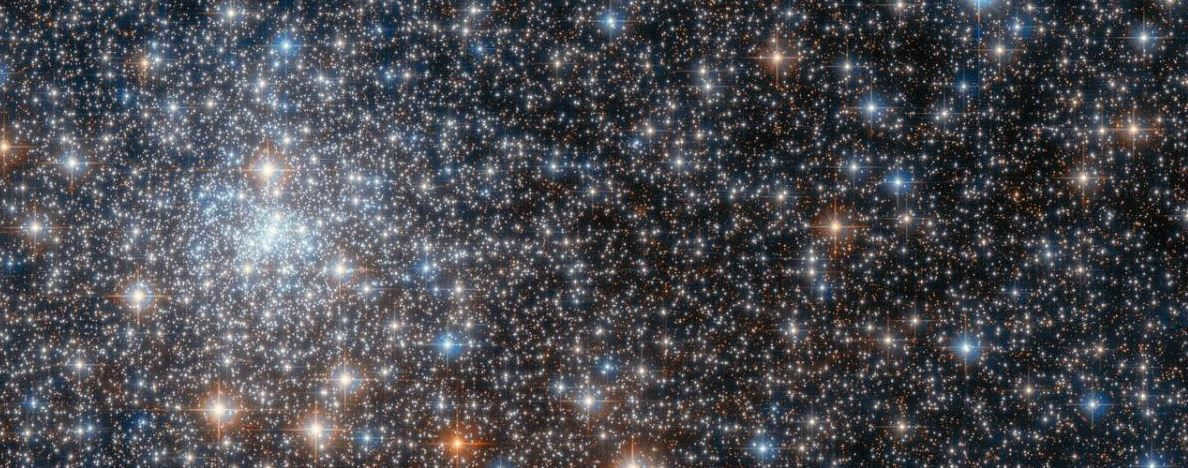
- Monsieur 28 is a spherical group of stars that can be found near Lambda Sagittarius, approximately 19,000 light-years away. It has a visible magnitude of 7.66 and contains 18 variable stars of the RR Lyra type. These variable stars are pulsating A or F stars with half the mass of our Sun. In 1986, Monsieur 28 became the first globular cluster to have a pulsar with a rotation period of 1 – 10 milliseconds discovered within it.
- Monsieur 55 is another globular cluster with an apparent visual magnitude of 7.42 and a distance of 17,300 light-years. It was first discovered by Nicolas Louis de Lacaille in 1751.
- Monsieur 69 is a globular cluster located 29,700 light-years away with a magnitude of 8.31. The cluster has a radius of 42 light-years and was discovered alongside the cluster M70 in 1780.
- M70 is a globular cluster positioned close to the galactic center, approximately 29,300 light-years from Earth. It has a visible magnitude of 9.06 and a radius spanning 34 light-years.
Locating M70
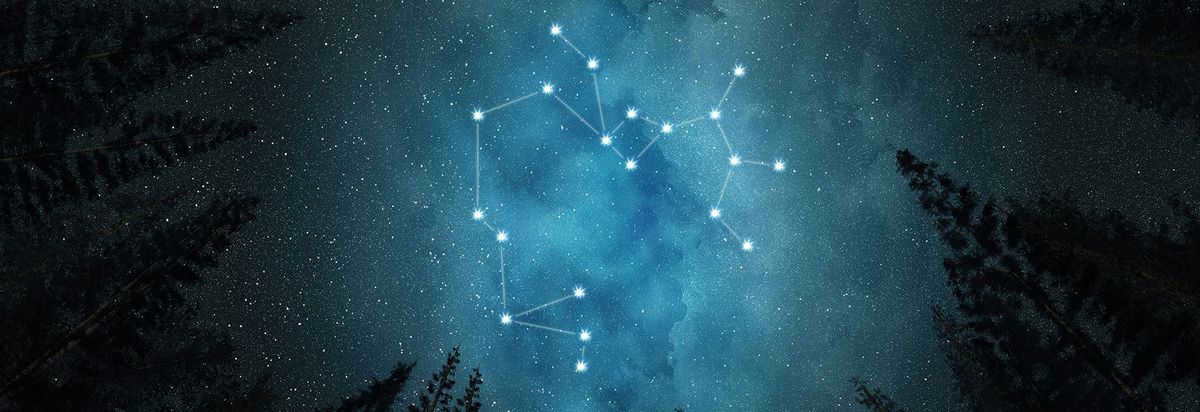
The optimal time for observing the Sagittarius constellation is between June 16 and July 22. The constellation reaches its highest point in the sky at midnight, with a right ascension ranging from 17h 36m to 20h 20m. It is best observed at latitudes ranging from +45 to -90 degrees, particularly in the southern part of the Russian Federation. However, it is not possible to observe Sagittarius from December 18 to January 18, as the Sun passes through the constellation during this period.
Visually, Sagittarius appears as an archer, which is why it is named as such. Conventionally, this cluster of stars is depicted as a centaur with a bow and arrow. It is the most prominent group of celestial objects in the southern hemisphere. Locating it is not a challenging task. It is flanked by Scorpio on one side and Capricorn on the other.
There are various methods to locate the constellation in the nocturnal expanse:
- By assisting you in locating the Sagittarius constellation, the Moon provides a helpful guide as it traverses the zodiacal circle on a monthly basis. For optimal visibility, it is recommended to observe the constellation either prior to the Moon’s arrival or after its departure, in order to avoid interference from starlight.
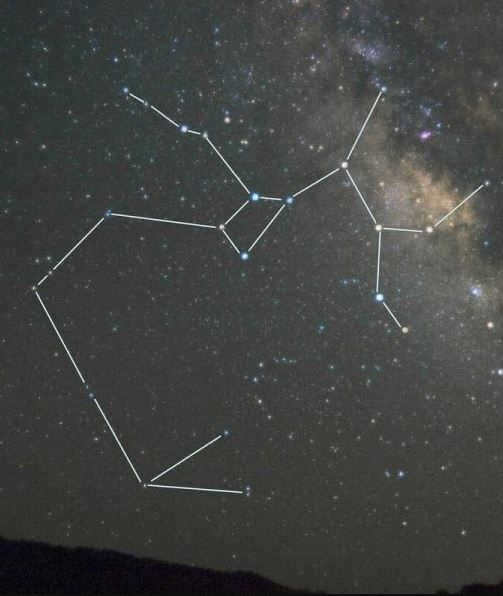
- To locate Sagittarius, you can start by “aiming” at the stars of the constellation from the direction of the “Summer Triangle” (the asterism “Summer Triangle” is a triangle formed by the stars Vega (Alpha Lyra), Altair (Alpha Eagle), Deneb (Alpha Swan)).
The most direct and accurate way to spot Sagittarius is to draw a line from the star Deneb (Epsilon of the Swan) through Altair and towards Nunki, the Sigma of Sagittarius. This line will pass near the Alpha Sagittarius Rukbat.
Notable groups of stars
Identifying Sagittarius in the night sky is aided by a number of its component groups of stars, known as asterisms, which are distinct patterns made up of stars but are not considered individual constellations.
Aside from the recognizable shapes of the arrows, bow, and centaur, the constellation also features:
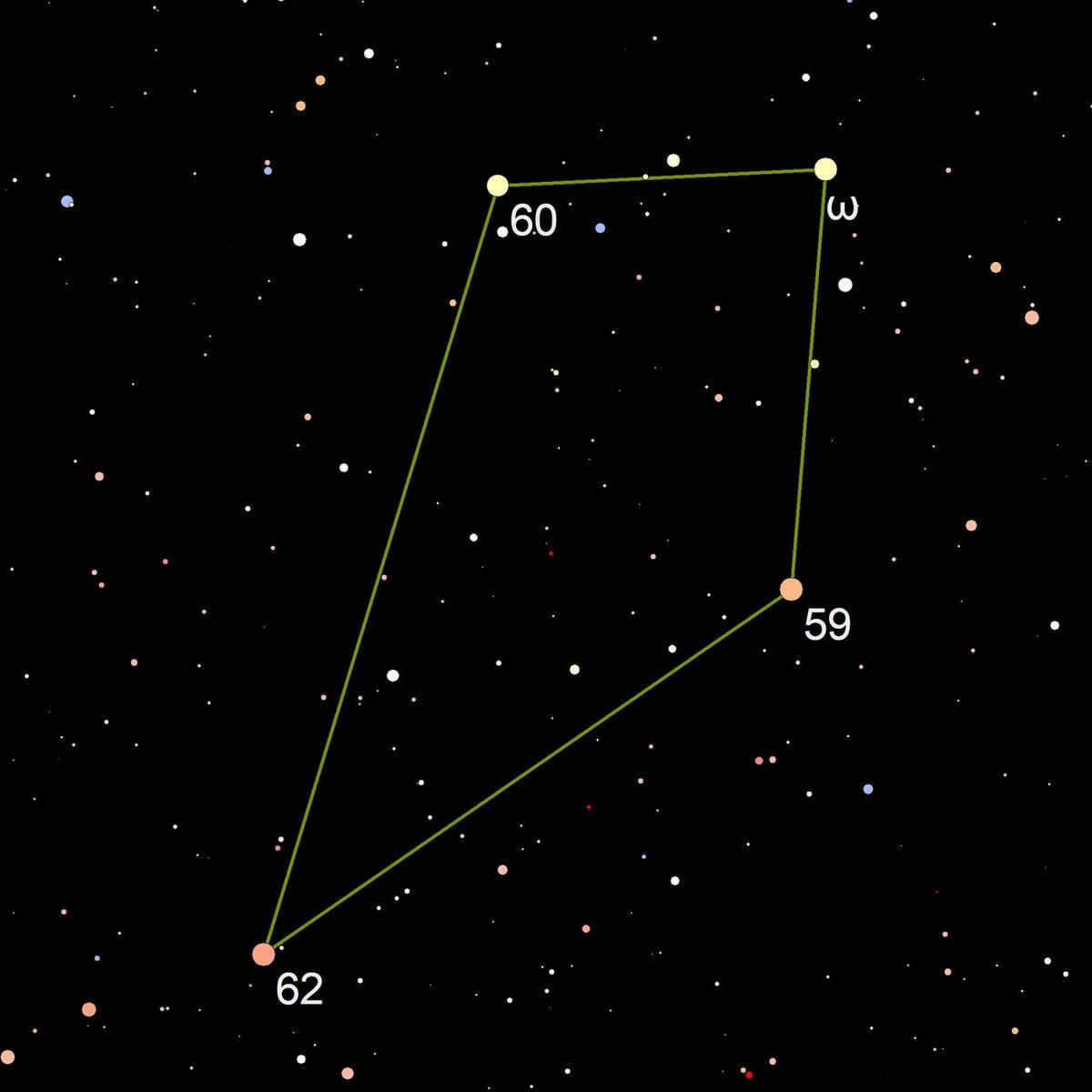
- Terebellum. Comprised of four bright stars, the Terebellum constellation takes the form of a quadrangle. These stars include Omega, 59, 60, and 62 of Sagittarius. The Terebellum constellation has ancient origins, just like the main Sagittarius constellation, which dates back to when it was first described and listed in Ptolemy’s major catalog.
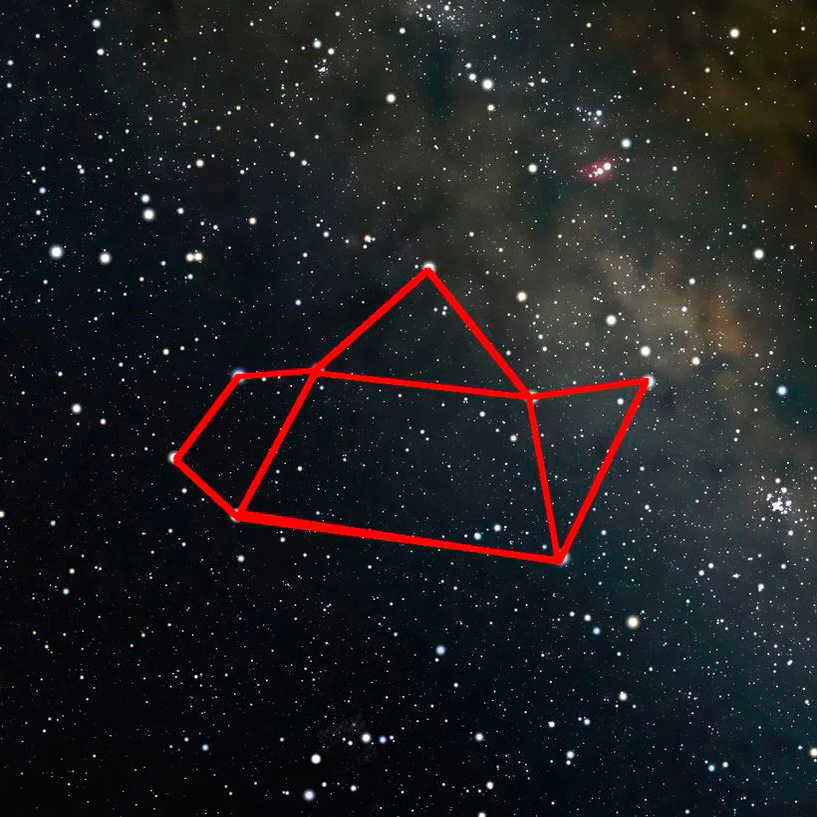
- Teapot. The outer elements of the subject are represented by the 7 brightest stars. The elements included in this formation are Gamma-2, Delta, Epsilon, Phi, Zeta, Tau, Sigma. When combined, they create a pattern of stars called an asterism, which has a handle, lid, and spout, giving it the appearance of a teapot.
- The Teaspoon is situated in the top left section of the constellation and is composed of five celestial bodies. It is adorned with the stars Nu, Ro-1, Pi, Omega, Xi-1, and Xi-2 of Sagittarius. These stars can be found to the northeast of the curved handle of The Teapot.
The asterisms The Kettle and The Teaspoon symbolize the customary English tea consumption. As a result, scholars associate them with a more recent European origin.
Queries regarding the Sagittarius constellation
Undoubtedly, during the 1970s, an American astronomer named Jerry Eyman managed to capture a signal referred to as the “WOW” signal using the Big Ear radio telescope. This signal originated from the direction of Sagittarius and was roughly translated as “Ogo” in Russian. However, there is no concrete evidence to support the notion that this signal originated from intelligent beings.
In Russia, the Sagittarius constellation can only be fully observed in the southern regions, where it appears high above the horizon. In central areas, such as Moscow and St. Petersburg, only a partial view of the constellation is possible as a significant portion of it lies beyond the horizon. In the Polar Regions and generally in the northern areas, the Sagittarius constellation is completely invisible.
Scientific Facts: A Video Review
The southern hemisphere is the only place where you can observe the complete Sagittarius constellation in the night sky. Locating it is fairly easy, especially with the help of the Eagle constellation, whose tail points directly towards Sagittarius. By tracing along the Milky Way from the Eagle, we will eventually come across Sagittarius. This constellation is often enhanced by the presence of passing planets. Covering an area of 867 square degrees, Sagittarius is comprised of around 120 stars that shine brighter than the sixth magnitude. In total, there are 204 stars that make up the constellation and are visible to the naked eye, including the prominent navigational star ε Sagittarius, also known as Kaus Australis.
Fascinating items
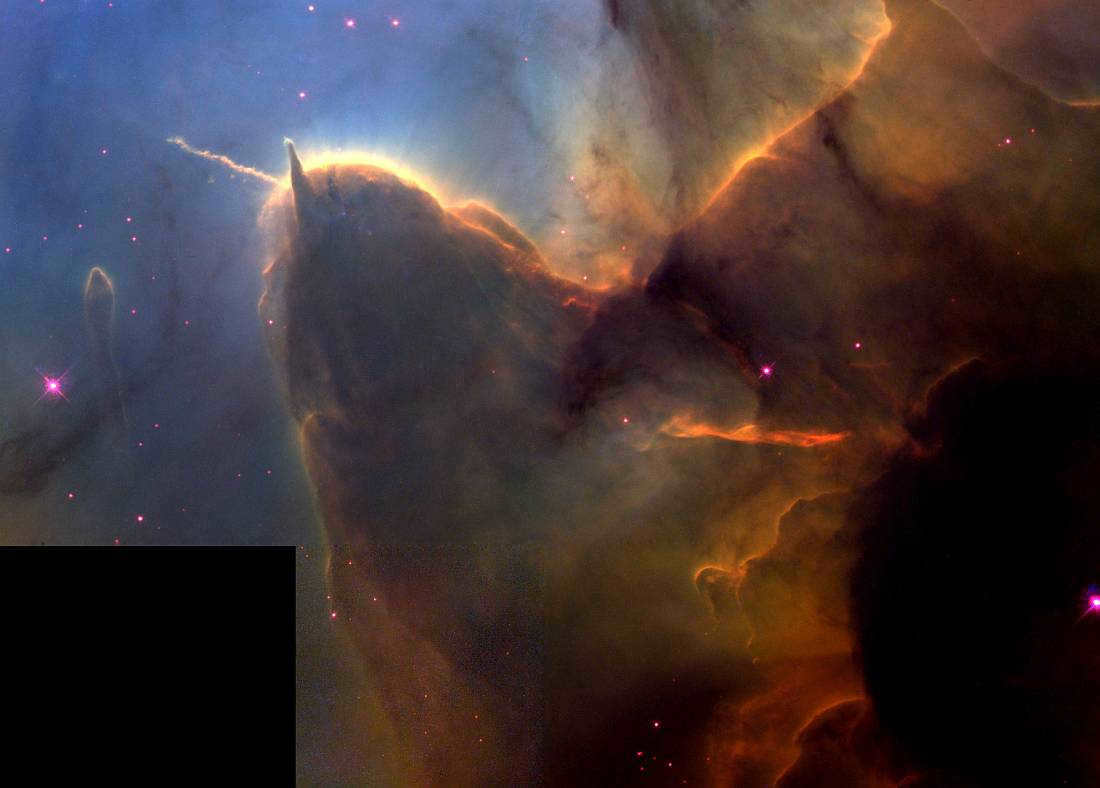
The constellation of Sagittarius contains the Laguna, Omega, and Triple (Swan, Horseshoe, and Triplet) nebulae. It also contains various scattered and globular clusters. Within Sagittarius, there are several prominent sources that can be observed in the radio spectrum, including the center of our galaxy.
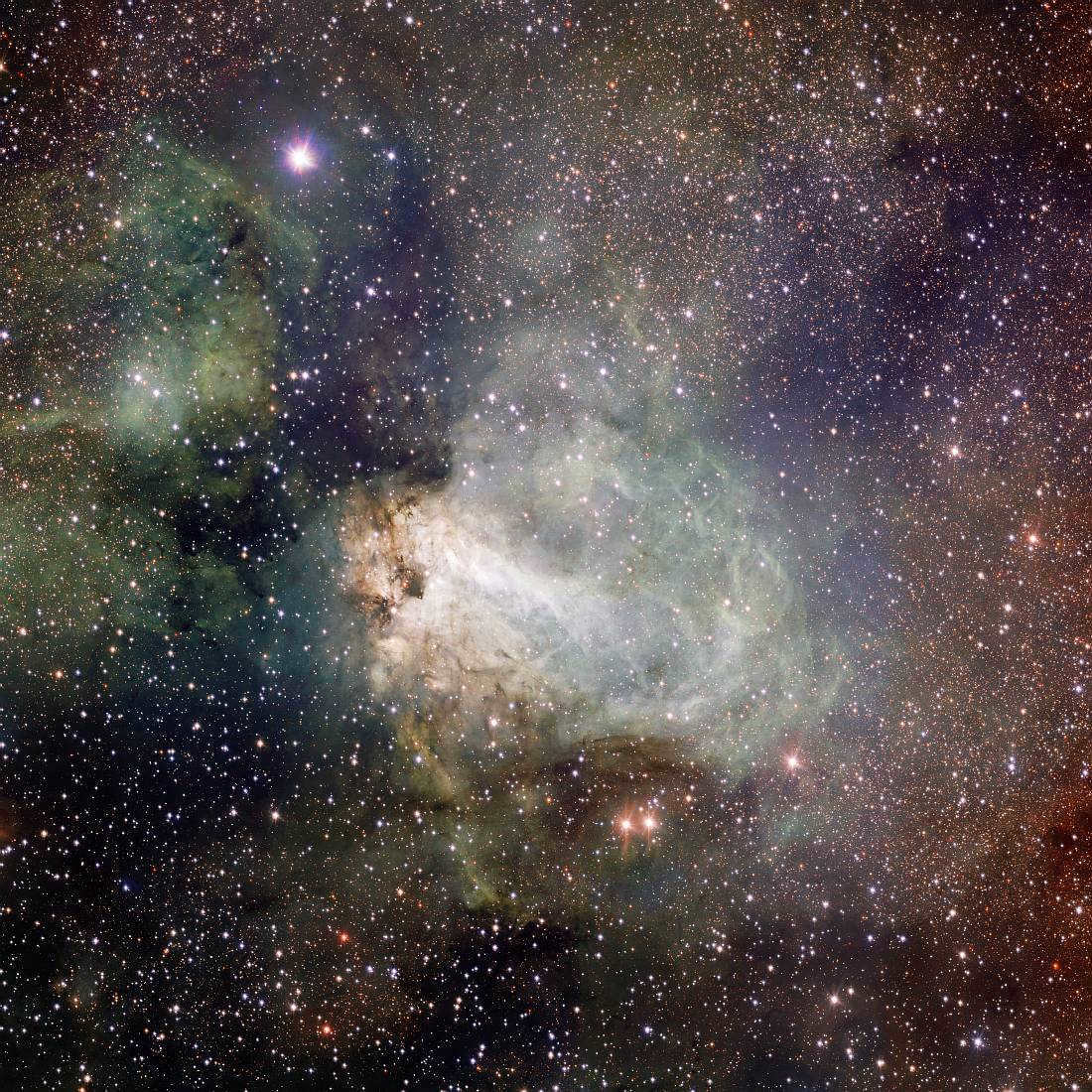
Embarking on a Journey to the Omega Nebula
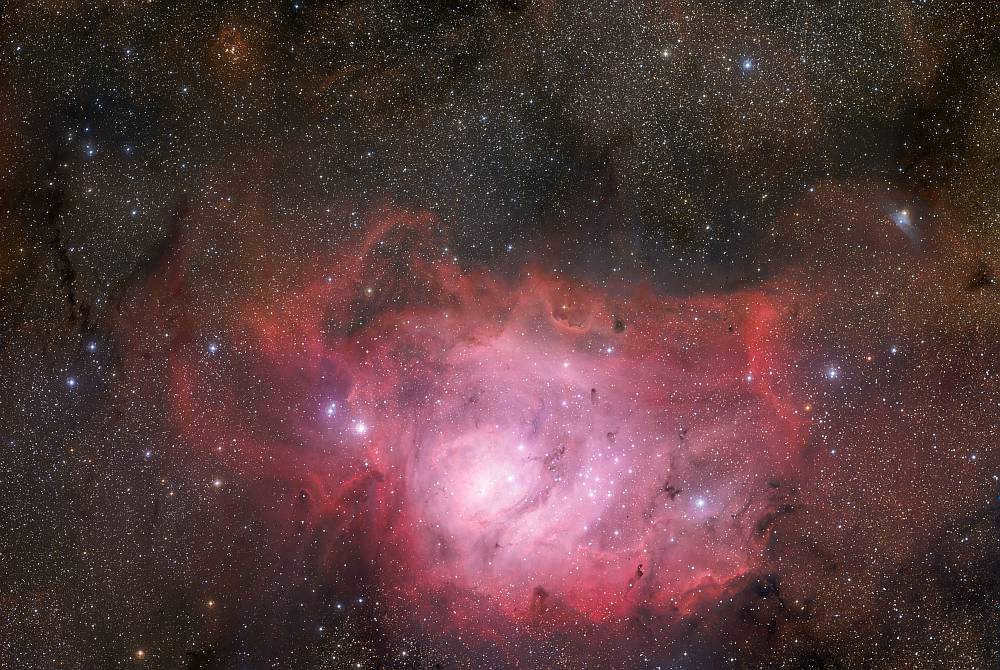
Embark on an adventure to the Lagoon Nebula
Exploring the heart of the Milky Way
Asterisms
An asterism is a group of stars that form a recognizable shape or pattern within a constellation. These star patterns are not official constellations, but they are often easier to identify and remember than the larger constellations themselves. Asterisms can be found in both the northern and southern hemispheres and can vary in size and complexity. Some well-known asterisms include the Big Dipper, which is part of the constellation Ursa Major, and the Summer Triangle, which is formed by three bright stars from different constellations. Exploring asterisms can be a fun way to navigate the night sky and learn more about the stars and constellations.
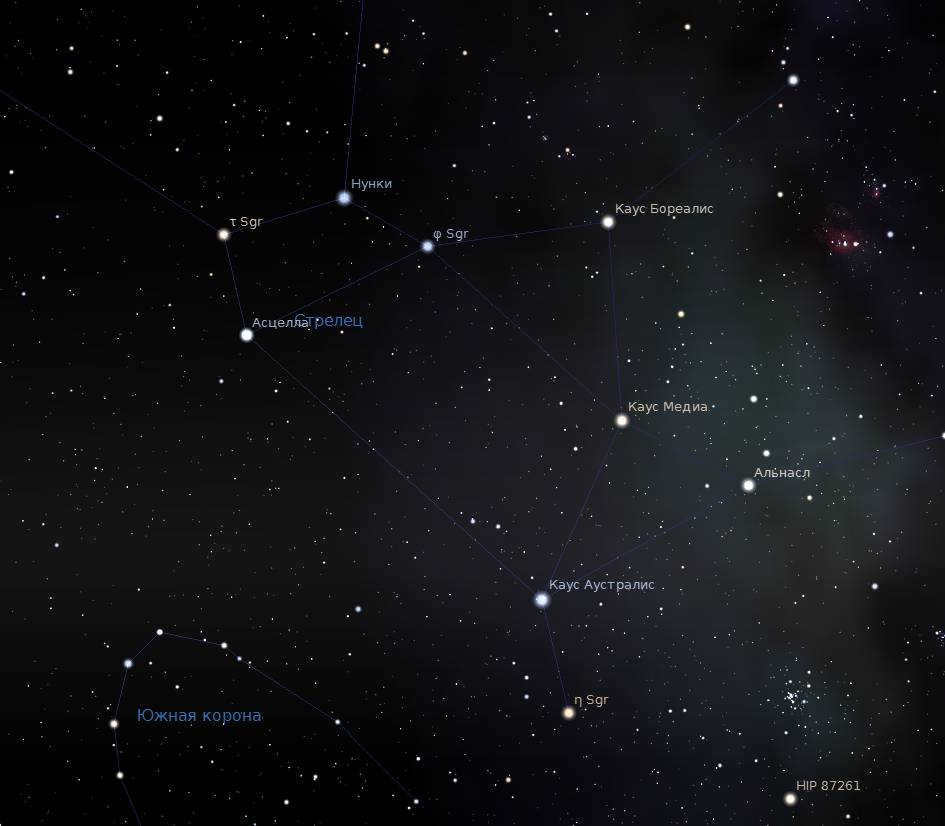
Can you spot a teapot shape in this image?
The asterism known as the Teapot consists of several stars and constellations, including Askela, Kaus Meridianalis, and Kaus Australis, which together form the shape of a teapot. Kaus Borealis represents the lid, Nunquit symbolizes the handle, and Alnazl serves as the spout. Additionally, the band of the Milky Way resembles pouring water, as if the teapot were pouring boiling water.
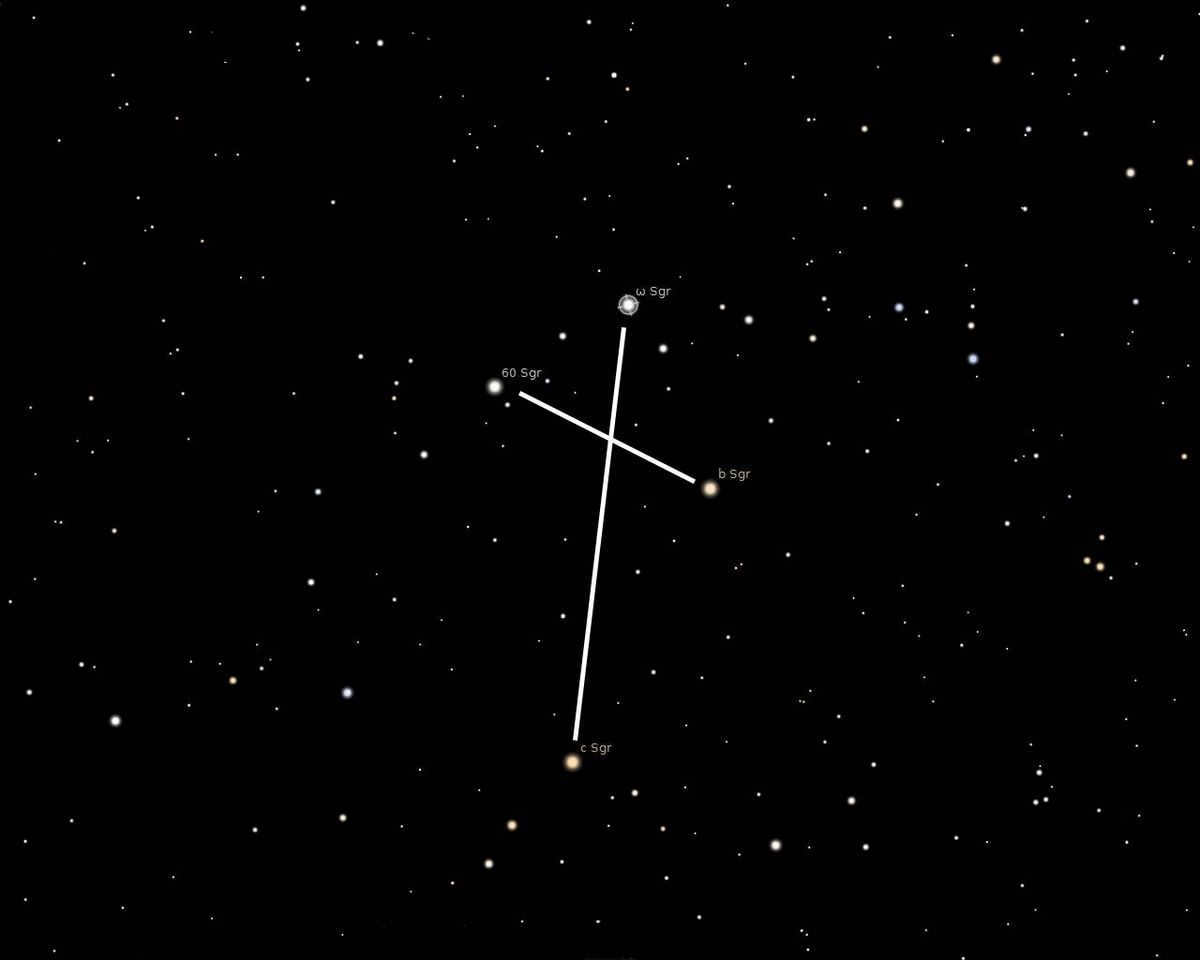
There is another tiny constellation called Terebellum, which bears a resemblance to a Catholic cross and comprises of four stars.
Galaxies
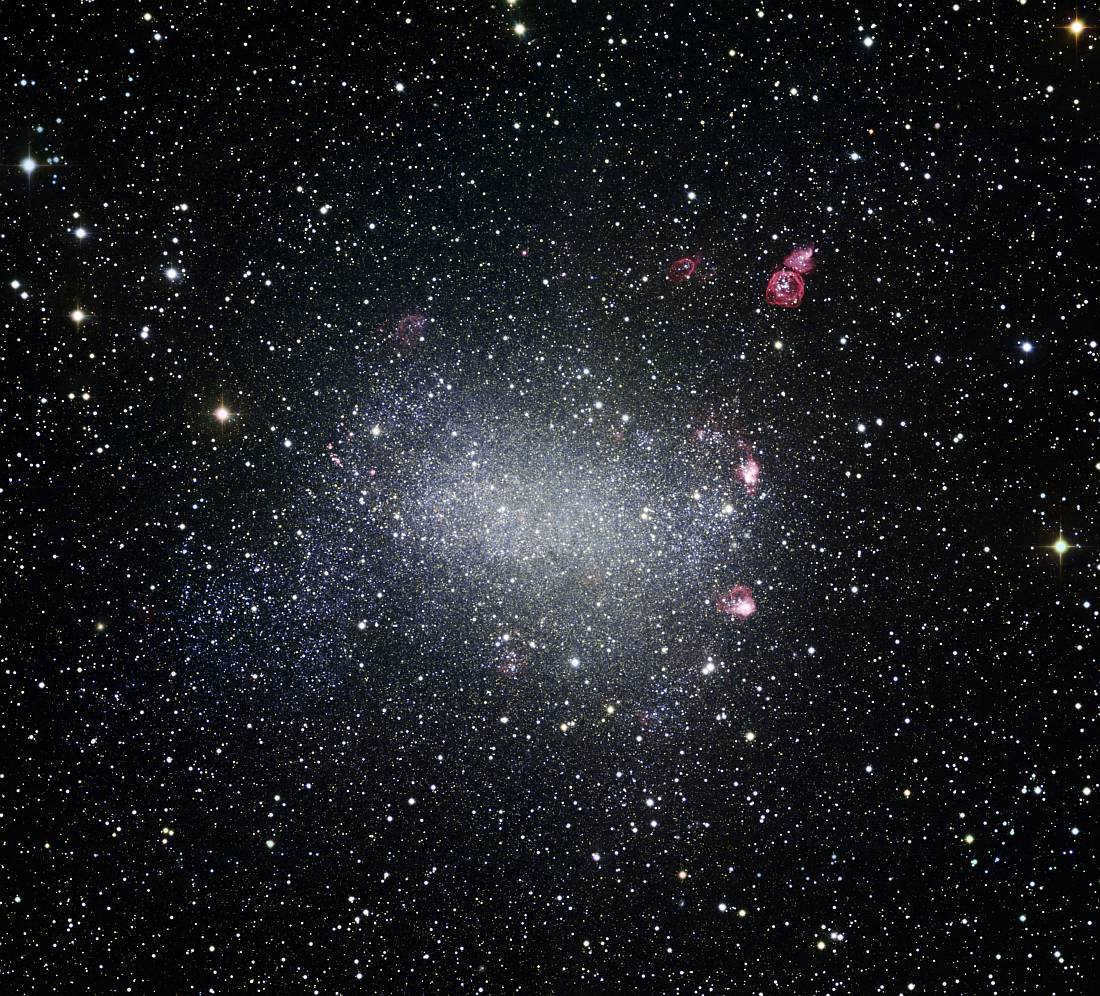
Photograph of the NGC 6822 Galaxy situated within the Sagittarius constellation.
Located relatively close to the Milky Way, in the northeastern region of the constellation, NGC 6822 is an irregular dwarf galaxy positioned approximately 1.7 million light-years away from our Sun. E. Barnard discovered this galaxy in 1884. In 2002, a planet orbiting the star OGLE-TR-56 was also detected.
NGC 6822, which is also referred to as the Barnard galaxy
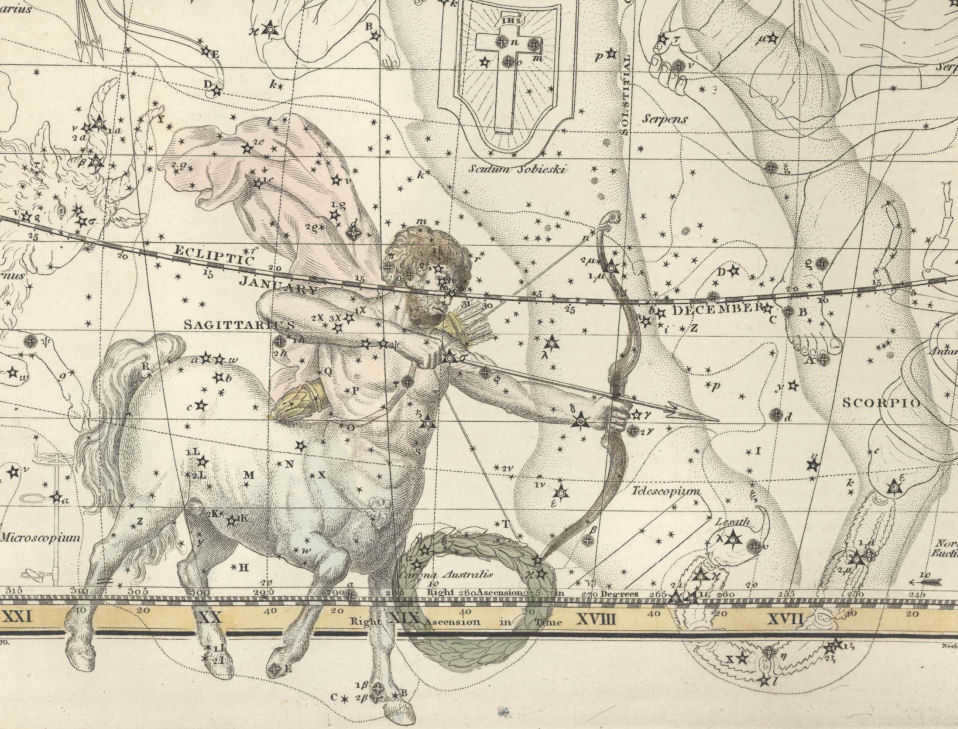
The constellation, which the ancient Greeks associated with a centaur – a mythical creature with a human upper body and a horse lower body, underwent a transformation in its depiction over the years. Initially, the constellation was portrayed with the centaur figure, but as time passed, it evolved into an archer, and eventually morphed into a representation of a bow and arrow on astronomical maps.
Outer space is home to an immense number of stars, which have captivated the curiosity and awe of humans for countless centuries. These celestial bodies that can be seen in the sky have been organized into different star clusters, including those within the zodiac. One such cluster is Sagittarius, which consists of approximately two hundred faint stars and a few intriguing objects.
Within the expansive group of stars that make up Sagittarius, only seven shine the brightest. They are identified by Greek letters and display a range of second or third stellar magnitudes, each belonging to various spectral classes.
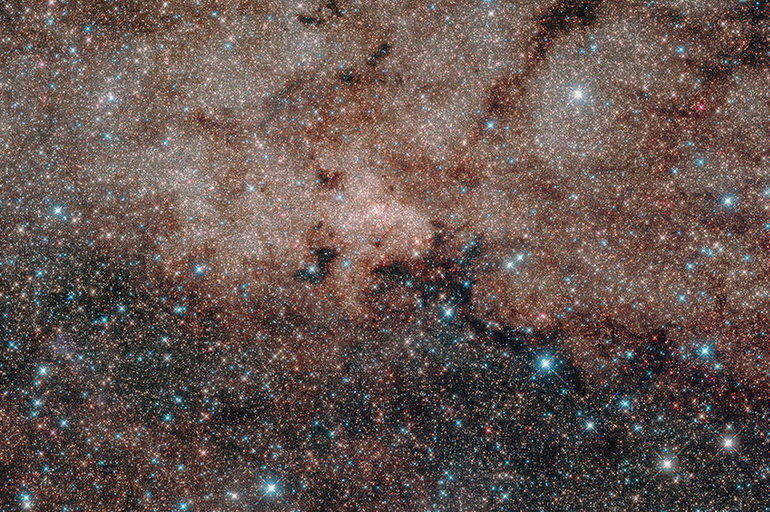
- Epsilon Causus Australis, which means “southern bow,” is the most luminous star in this constellation. It is a binary star system with a dwarf companion. It outshines the Sun by nearly 400 times and has a mass and radius 5 and 7 times greater than the Sun, respectively. It has a right ascension of 18 hours 24 minutes and a declination of -34 degrees 23 minutes.
- Sigma Nunca or Pelaguc, also known as the “rushing stream,” is a blue star that comes second in brightness after the Southern Onion. Its coordinates are longitude 18 hours 55 minutes and latitude 26 degrees 17 minutes. It has a mass equal to 8 times that of the Sun and a radius of 4.5 times.
- Zeta Ascella is a binary star with a white color and a combined brightness. In terms of brightness, it is the third brightest star after sigma and epsilon. The system consists of a giant star and a subgiant star, with apparent magnitudes of 3.26 and 3.37, respectively.
- Delta Causus Medius is a star system composed of multiple stars, with a yellow-orange spectrum.
- Lambda Causus Borealis is a subgiant star with a yellow-orange color located 2.1 degrees south of the Sun’s apparent motion. It can sometimes be covered by the Moon or other planets.
- Pi Albaldah, which means “city” in Arabic, is a triple star system with a massive star and a yellow spectrum. Its brightness is about 1,000 times greater than that of the Sun. It is interesting due to its unstable gravity and internal pressure, which causes it to periodically expand and contract.
- Gamma Nasl, Nushaba, is an extraordinary star with a dual moniker signifying “arrowhead.” Its surface temperature, mass, and luminosity surpass the Sun by several fold.
The most radiant star clusters serve as navigational landmarks and are easily observable in the southern celestial region. In contrast, Alpha (Rukbat) and Beta, possess relatively lower luminosity and reside on the outskirts of the system.
To locate Sagittarius amidst other stars, which number around two hundred within its boundaries, one must acquaint oneself with the roster of the most prominent discernible entities within this constellation. Given that “Sagittarius” is a constellation of the southern hemisphere, it is entirely observable in the southern regions of Russia, as well as in subtropical and tropical areas. Nonetheless, even in the temperate zone, it may be partially visible on summer evenings. Multiple methods exist for locating the “centaur”:
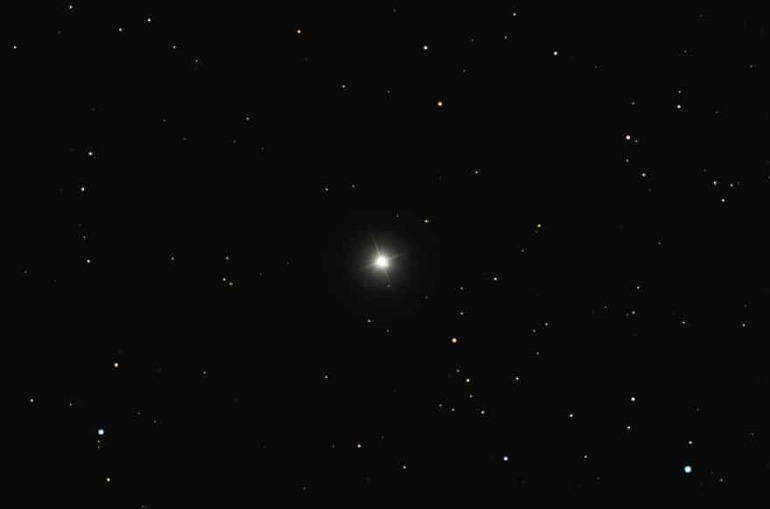
- By utilizing Polaris as a guide, one can trace a visual line to Lyra. By extending this line for a similar distance, it will intersect with the “arrow” of the constellation.
- Another method is through the Summer Triangle, which is formed by the prominent stars of Eagle, Lyra, and Swan (Altair, Vega, and Deneb, respectively). The most precise and shortest route is a line from the epsilon star in the Swan system, passing through the alpha star in Eagle, and terminating at the sigma star in the “archer” Nunca. If you draw a line from Alpha Swan and pass it through Altair, it will be in close proximity to the primary star in the “centaur” known as Rubkat.
- By harnessing the power of Earth’s natural satellite, the Moon, we can observe its regular journey through the zodiacal circle every month. In the first decade of August, it aligns with a specific constellation.
These widely applicable techniques enable us to observe Sagittarius in regions where it may not be visible in its entirety. Flanking Sagittarius are two other constellations, Capricorn and Scorpio.
The primary constellations
When studying the appearance of the Sagittarius constellation, it is important to familiarize yourself with several primary constellations. These are recognizable patterns formed by stars, but they are not considered separate constellations. Alongside the arrows, bow, and centaur, there are several other patterns that make up the “archer”:
- The terebellum is made up of four bright stars and takes the shape of a quadrilateral.
- The teapot consists of the seven brightest stars that form the outer parts of this celestial object.
- The spoon is located in the upper left part of the constellation and is composed of five bright stars.

The terebellum has a long history, tracing back to ancient times. It can be traced back to the era when the “archer” constellation was first recorded and included in Ptolemy’s catalog. The other two designs were connected to the English tea party and are believed to have originated in Europe at a later date.
Legends and myths
There exist numerous tales, historical accounts, and myths linked to the constellation. The illustration portraying it features a fantastical being with a human upper torso and a horse’s lower body. The centaur is depicted with a taut bowstring and an arrow aimed directly at Scorpius. Sagittarius stands as the sole constellation that displays both aggression and embodies elements of both human and animal simultaneously.
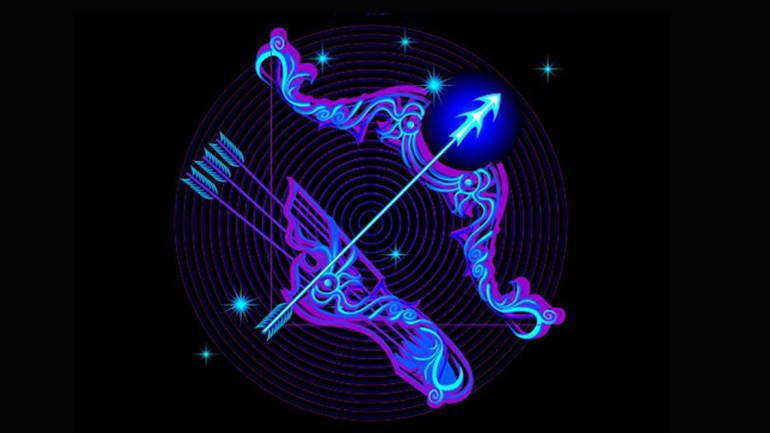
References to the “archer” can be found among the ancient Sumerians and the people of Mesopotamia. The most widely known myth is about the wise Chiron, who was the son of Saturn. Chiron received training in playing various musical instruments, healing, and hunting from a young age. He later passed on this knowledge to Heracles, Achilles, Pollux, Jason, and Castor.
According to the legend, the heavily wounded Chiron took Prometheus’ place on the rock. In doing so, he freed the god from his curse and suffering, but also hastened his own demise. In appreciation for his noble act, the supreme god Jupiter immortalized the centaur in the sky.

There is another version of the story based on the perspective of the ancient myth makers. According to this tale, Chiron, a highly educated being, created a star globe for the Argonauts. He left a few empty spaces on the globe for himself and his friends, with the intention of being the first to appear in the sky. However, he was surpassed by another centaur named Krotos. Krotos is credited with inventing the bow and was a masterful archer. Legend has it that Krotos ascended into the sky just as he was about to use his bow.
There are numerous legends associated with this constellation, as researchers have discovered references to it in the folklore of various cultures. Historians believe that all the accounts of this mythical creature are connected to the realm of the deceased, and the names and events often overlap.
Aside from a multitude of stars within the constellation Sagittarius, there are also several captivating astronomical features – nebulae. Among the most renowned entities are:
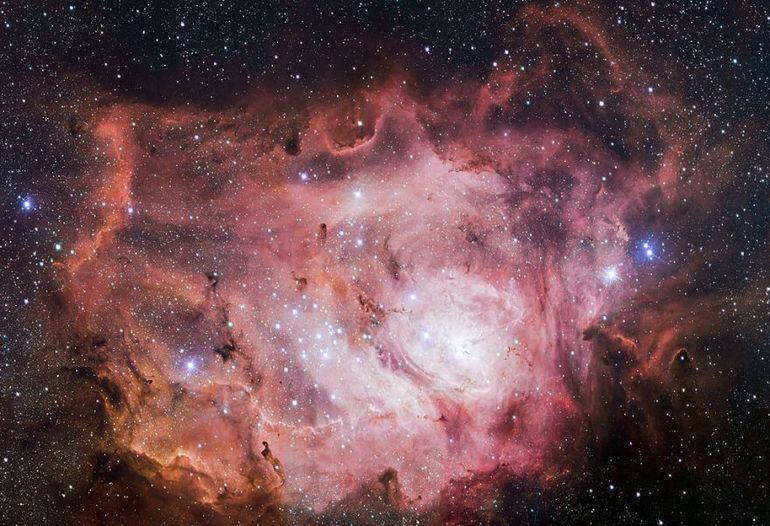
- The Lagoon (M8) is a vast celestial cloud composed of ionized hydrogen. Its boundaries have an oval shape, and the core resembles the petals of a flower made up of stars. This star cloud is visible in the night sky without any special equipment, and can also be observed with regular binoculars.
- The Triple (M20) has a dominant red color, which is caused by the abundance of hydrogen in the cloud. The area is scattered with young blue stars, creating a stunning contrast against the overall background. The nebula showcases three distinct colors: emission pink, reflection blue, and absorption black. This cloud can be observed using a telescope.
Astronomy lovers are drawn not only to the globular clusters and colorful nebulae that are clustered in the Sagittarius constellation. Fascinating details include the existence of a gigantic black hole and its close proximity to the galactic center. This particular region of space is obscured by clouds of gas. A significant milestone that took place in 1977 was the reception of the WOW message from this area of the cosmos. This widely known signal is believed to be a sign of extraterrestrial intelligence.
Astrological description
Sagittarius is a zodiac sign that represents individuals born between November 23rd and December 21st. The key features of Sagittarius are as follows:
- Element – Fire;
- Symbol – a bow and arrow;
- Stone – quartz, garnet;
- Planet – Jupiter.
Sagittarians are individuals with a charismatic personality. They are known for their boundless energy and cheerful nature. Depending on the positioning of the Sun in the horoscope, Sagittarians can pursue various paths, ranging from religious pursuits to international business ventures.

Men achieve great heights through their ingenuity, luck, or acquired connections. They possess qualities such as generosity, kindness, foresight, and optimism. The only downside is their tendency to communicate in a condescending manner, which reveals their pride.
Women have an inherent desire for a vibrant and luxurious life. They have a great sense of humor and are known for their straightforwardness. They enjoy being a friendly and warm hostess, welcoming friends into their homes.
The Sagittarius child has a strong fear of loneliness. They are highly active and sociable, with a curiosity about the world around them. When interacting with their peers, the little “archer” strives for superiority and popularity. Their benevolence and sense of justice prevent them from seeking out conflicts, although their excessive directness can sometimes lead to disagreements.
The uniqueness of this constellation lies not only in its fascinating astrological details. “Archer” is also distinctive in having the largest gathering of stars, which creates a vast cosmic city, adorned with a dazzling array of colorful lights.

Sagittarius, located in the southern part of the sky, is a fascinating constellation within the zodiacal group. Due to its position in our Milky Way, it can be easily observed in the night sky.
Moreover, Sagittarius spans a vast expanse of space, specifically 867 square degrees. This impressive size places it as the 15th largest constellation in terms of area.

Historically, this particular portion of the heavens has been recognized since ancient times. In reality, there exist multiple theories regarding its origin. Primarily, it is ascribed to the ancient Greek legend of the centaur Krotos. The constellation Sagittarius is also associated with the centaur Chiron. Chiron is credited with inventing the celestial globe for the Argonauts. In this globe, he reserved a spot for himself, but it was Krotos who first occupied it. As a result, Chiron was allotted the remaining section of the sky adorned with stars.
In any event, this region represents an archer, or more precisely, a centaur wielding a bow and arrow.

Constellation Sagittarius: Stars in Formation
This region boasts the highest number of variable stars compared to any other. It is also the location of the winter solstice point and the center of the Milky Way.
The most brilliant star in this vicinity is Epsilon — Kaus Australis, which signifies the southern part of the bow. It is actually a binary star with an apparent magnitude of 1.85.
Coming in second place is Sigma — Nunki, a blue-colored subgiant. Its brightness measures 2.05.
In third place, we have Zeta, also known as Askella, meaning armpit. This star is categorized as a double star and has a visual magnitude of 2.59.
Coming up next. Delta – Kaus Media. This refers to a medium-sized bow. It is similar to the one mentioned earlier, being a binary star system composed of a giant star and a subgiant star. It has a visibility index of 2.7.
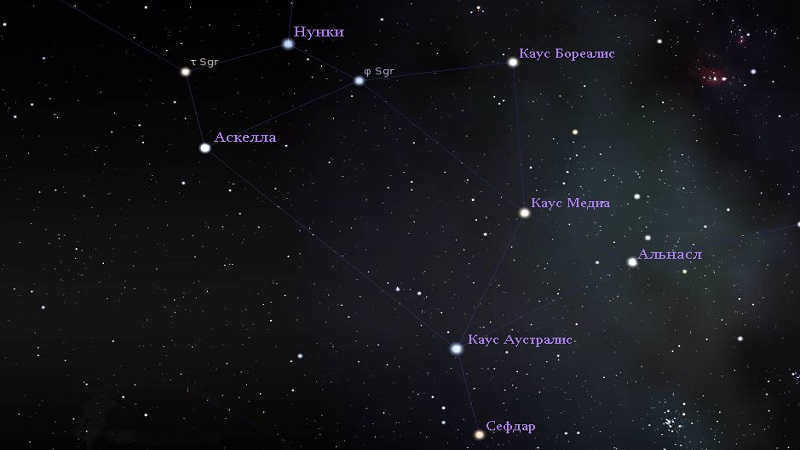
Moreover, the star known as Lambda is referred to as Kaus Borealis, which is the northern onion. It is classified as an orange giant with a size of 2.81.
Additionally, Pi — Albaldach is a triple system that is named after a city. It has an apparent magnitude of 2.89.
Furthermore, Gamma — Alnasl is the star that marks the arrowhead in the constellation. It belongs to the category of giant luminaries, has an orange color, and has a brightness of 2.98.
In this constellation, there is a double system called Sefdar, consisting of a giant and a dwarf star. The average visual magnitude of this system is 3.11.
Lastly, Phi is classified as a blue-colored giant star, with an apparent magnitude of 3.17.
Omicron and Ro Sagittarius are classified as binary stars. Their visual magnitudes are 3.76 and 3.92, respectively.
Mu – Polis, which means stallion, is a multiple system with an apparent magnitude of 3.85.
Other celestial objects
Lastly, Alpha is a dwarf star in the constellation Rukbat that represents the knee of an archer. It has a visual magnitude of 3.97.
By the way, the designation Beta refers to two objects. First, it is a binary star Beta-1 consisting of a pair of dwarfs with a total luminosity of 3.96. Second, Beta 2 is a blue giant with an apparent luminosity of 4.27.
Theta-1 is a binary star with an apparent luminosity of 4.37.
Omega is a yellow-colored subgiant with a visual magnitude of 4.7.
Nu is a star system consisting of three stars and has a combined apparent magnitude of 4.86.
It is important to mention that this star is located in the center of the Pistol constellation, which is named after the nebula it illuminates. This unique celestial object is known for its distinct blue color.
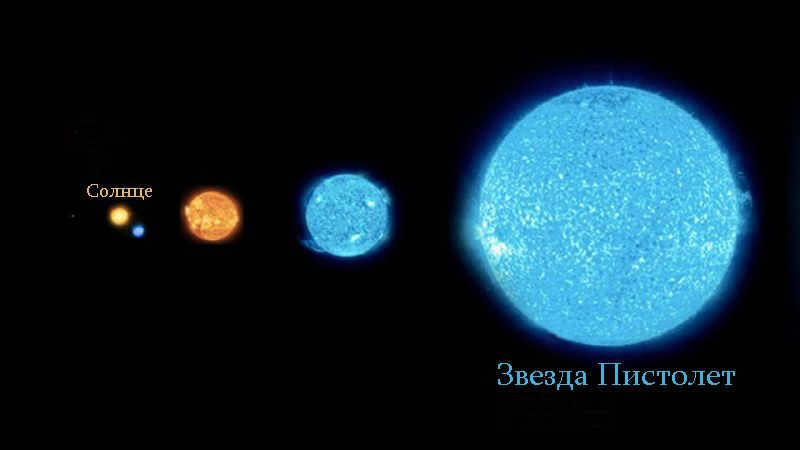
Moreover, there has been a detection of a diminutive star. Named Ross 154, it happens to be the nearest among the constellations to our solar system. Due to its capability to emit short bursts of light, it is regarded as an ostentatious kind. UV China.
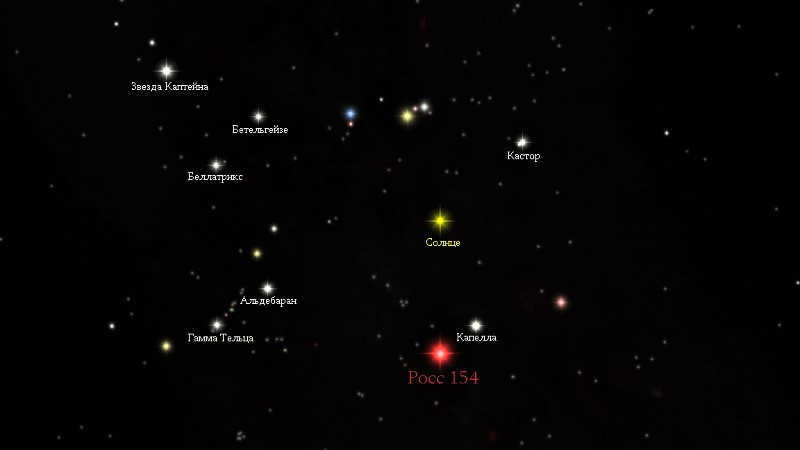
What celestial objects are found within the Sagittarius constellation?
Interestingly, this region contains numerous noteworthy astronomical entities. To illustrate, we can draw attention to a couple of intriguing formations.
Sagittarius A is an remnants of a supernova and a prominent radio source situated at the very core of the Milky Way. It proves challenging to observe due to the presence of dense dust clouds surrounding it. Speculations suggest it may have hosted a supermassive black hole.
Furthermore, there is Sagittarius B2, an immense molecular cloud composed of dust and gas. It ranks among the largest such clouds within the Milky Way galaxy.
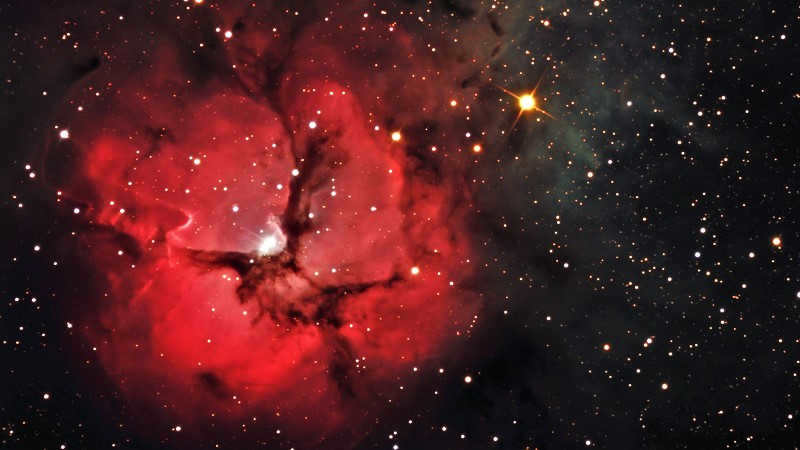
There are numerous Messier objects present in this region. Primarily, there are emission nebulae that exhibit active star formation. These include:
- Lagoon or M8 – a considerably extensive interstellar cloud. It is a prominent object that houses another nebula called Hourglass.
- Omega, also known as M17 or Swan, Horseshoe, and Lobster. Scientists estimate that it contains a diffuse cluster of 35 young, hot celestial bodies.
- The Triple Nebula, also known as M20, is a luminous area comprised of both emission and reflection components, as well as hosting a cluster of stars.
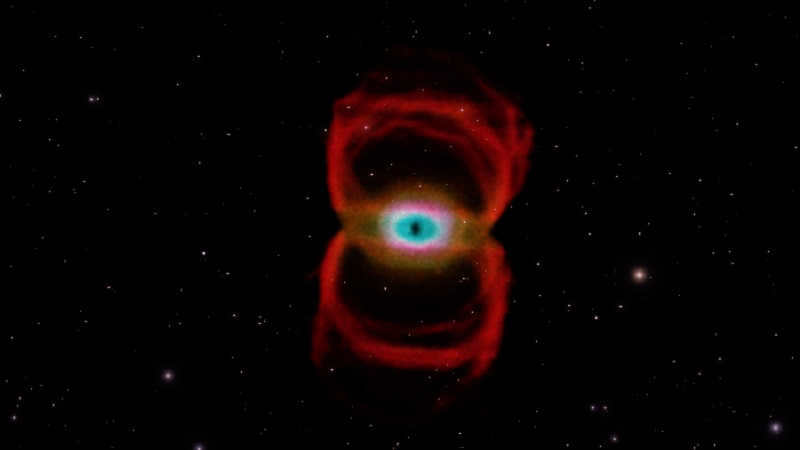
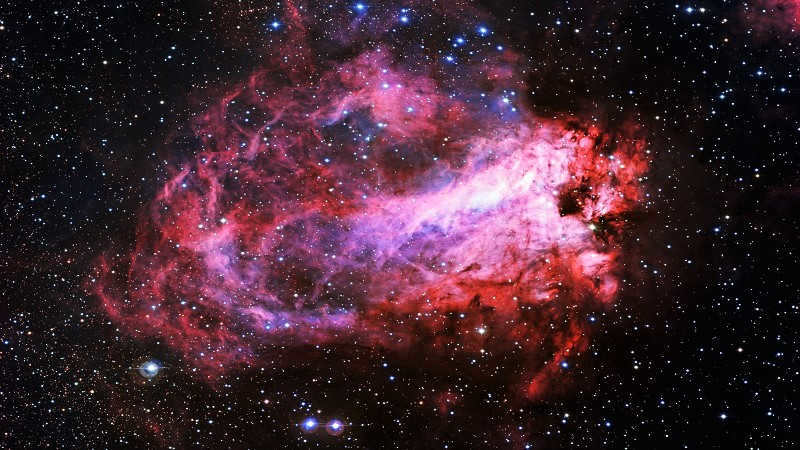
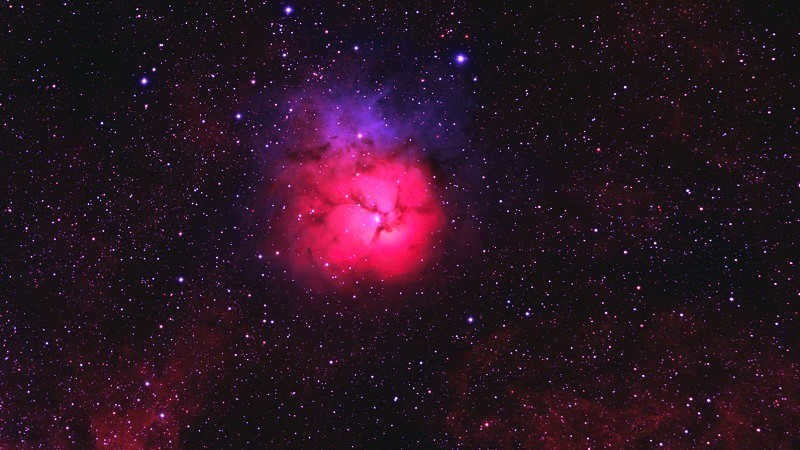
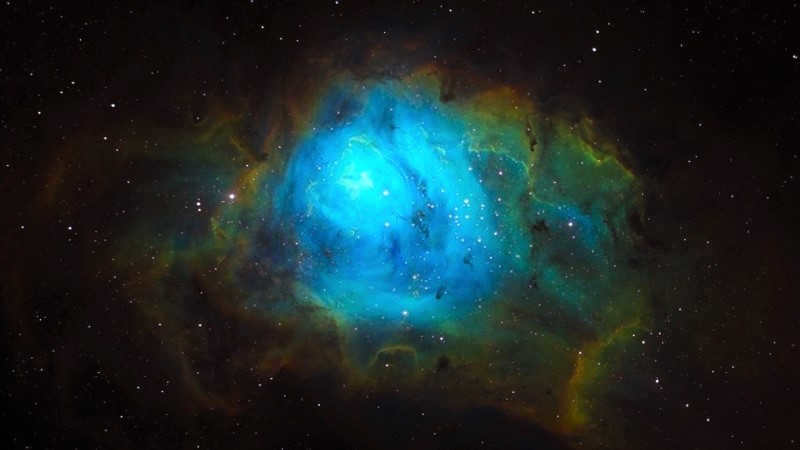
What other secrets does the constellation Sagittarius hold?
Furthermore, there is a dense Sagittarius star cloud (M24) that also showcases the fascinating process of star formation.
Additionally, the constellation Sagittarius is home to several open clusters including M18, M21, M22, M23, and M25. It is worth noting that Messier 22 is one of the brightest and even contains a planetary nebula.
Moreover, this area contains several globular star clusters such as M28, M54, M55, M69, M70, and M75. Particularly intriguing is Messier 28, which houses 18 variable pulsating luminaries like RR Lyrae. Interestingly, it is also the first globular cluster where a pulsar with a millisecond rotation period was discovered.
Nonetheless, subsequent findings have revealed the existence of additional globular star clusters. Take, for instance, NGC 6722 and NGC 6523.
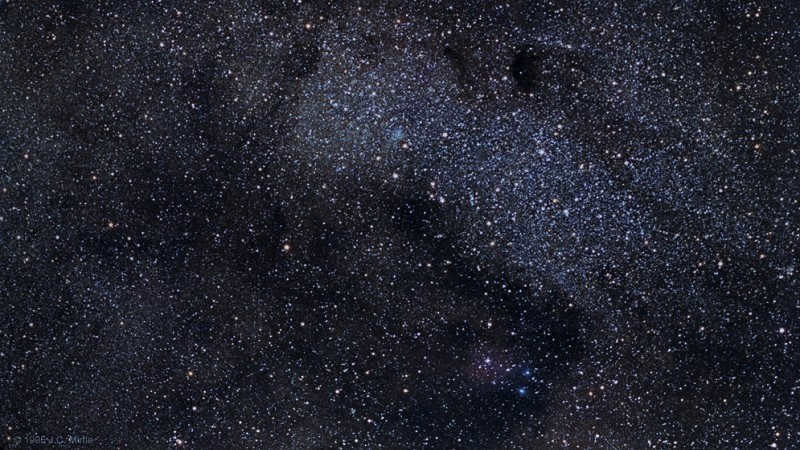
Furthermore, within the boundaries of the Sagittarius constellation, there are the planetary nebulae known as NGC 6565, NGC 6578, and NGC 6818.
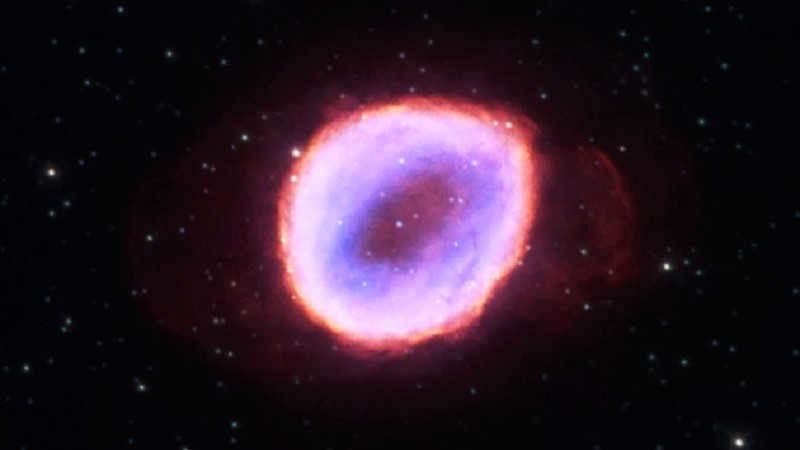
In addition, two dwarf galaxies in the Sagittarius constellation have been discovered:
- One is an elliptical galaxy with a unique loop-like shape. Interestingly, it is in close proximity to the Milky Way and there is a possibility of a future collision between the two.
- The other is an irregular galaxy with stars of intermediate age.
Here lies the irregular Barnard galaxy which is part of the Local Galactic Group. It also contains an emission nebula known as the Bubble, which consists of clouds of ionized gas.
There are also two meteor streams observed in this region – the Sagittarids and the Phi Sagittarids.
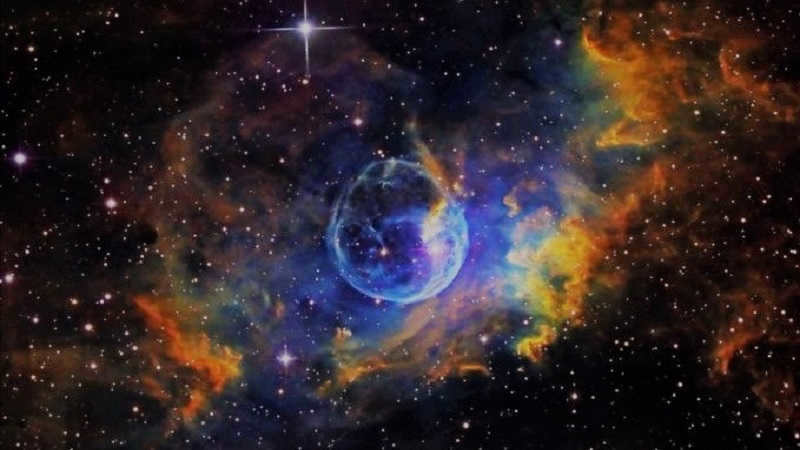
The constellation Sagittarius is comprised of the following asterisms
Firstly, there is a cluster of stars known as the Teapot. These stars include Delta, Epsilon, Gamma-2, Lambda, Zeta, Phi, Sigma, and Tau. Due to the arrangement of these stars resembling a teapot, it has been given that nickname.
Secondly, there is the asterism Terebellum, which is a small quadrilateral formed by Omega and the stars 59, 60, and 62 of Sagittarius. It has a similar shape to a cross.





